#chronotsr
Explore tagged Tumblr posts
Text
No. 1 - G1, The Steading of the Hill Giant Chief (July 1978)
Author(s): Gary Gygax Artist(s): Erol Otus, Dave C. Sutherland III (cover), David A. Trampier Level range: Average of 9, preferably 5+ players Theme: Standard Swords and Sorcery Major re-releases: G1-3 Against the Giants, GDQ1-7 Queen of the Spiders, Against the Giants: The Liberation of Geoff, Dungeon #197, Tales from the Yawning Portal
I'm not sure if G1-G3 are the most remastered adventures of all time, but it's gotta be competitive. I think Tomb of Horrors might have it beat, but I haven't counted. The 4e conversion [the Dungeon #197 one] is really weird in particular because…4e feels like the edition least interested in the legacy of DND? It was boldly doing its own thing. A good quality, actually.
Anyway, it's time to slag off* on a beloved adventure. Note, I am using the earliest copy of G1 I can find, which is from waaaay later when D3 was complete. I apologize.
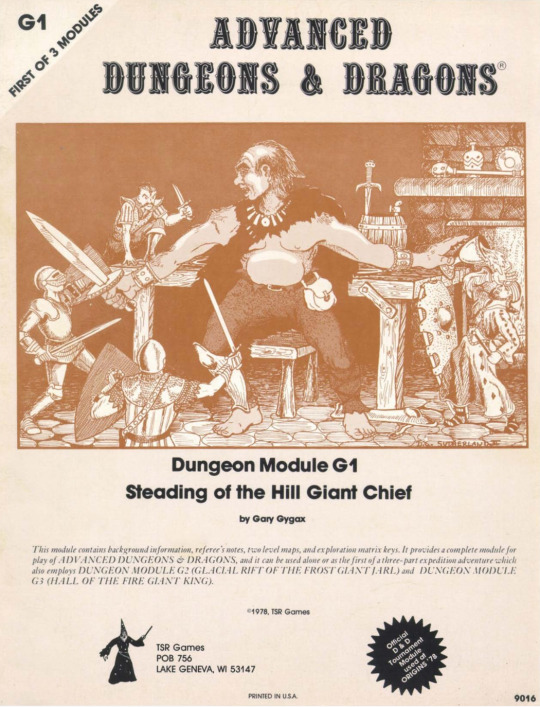
*And by slag off, I mean "be critical of at all". In practice, this module is actually showing some unusual acumen compared to its contemporaries.
EDIT: I forgot to mention a rather important thing when this was made live -- note the title there! We are officially in ADND land now, so put away your little brown booklets and switch over to the fuck-off awesome player's handbook with the iconic Moloch statue!
Somehow I had gotten my whole life at this point never really…understanding what this structure was supposed to look like? It looks like this.

I honestly think exterior shots of dungeons are critically underrated. Handouts are amazing and being able to flash the back cover art to safely show the party "like this" is actually great, I deeply wish that….any? of the previous modules had done that? I think the only one that did was Tsojconth. Weirdly, the interior drawing is very subtly different. Look at how the logs face:
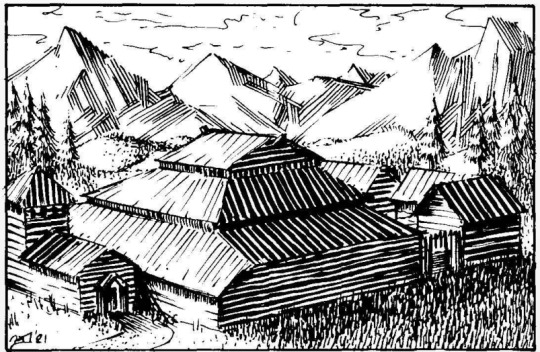
Not a huge deal but, a kind of weird inconsistency that top one looks like a stockade and the bottom one looks like a log cabin. Side note, we know that the long dimension of this is using 210 feet tall logs, which is to say, the size of an average redwood. These are some big fuck-off trees -- which could be a very interesting detail about the local area.
Now the setup is pretty simple. You were hired to go beat up the giants because they've been raiding the local humans, figure out why they're raiding, and comeback posthaste. The locals have kitted you out with horses, guides, maps, et c -- but no compensation, they have simply omitted a finder's fee (cheap bastards). Also, if you fail, they'll execute you. With friends like these, who needs Giants?
Gary starts with some mild railroading (you accepted the job already, you are already kitted out, you already walked to a nearby cave, you waited til dusk to approach, you notice two guards are missing, and the cave is guaranteed to be moderately hidden. Sure, whatever, I'm going to ignore that if I run this tho. Gary notifies us of a few critical details:
Don't run this stock, that's immoral
Any surviving giants will flee to G2 if they have the opportunity (which, kind of inherently punishes clever play that avoids combat?)
There is a 2% chance per round that the wooden structure will be lit on fire due to chronic rain (why is this a dice roll??)
If you will permit me a tangent, player arson is truly the bane of interesting scenarios everywhere. Whenever a player wonders, "why are all the GM's dungeons underground or in stonework buildings?", it's because doing anything else invites arson as the default and best answer to all problems. Magic items are fireproof and most metal items will not get hot enough to be destroyed, so very often the best solution is to burn the place to the ground and loot it the next day. So, yeah. No wood buildings. Gary's fix is to have all the giants flee into the basement, then waste a week of the PC's time for daring to use arson. Kind of sucks!
Tangent complete.
Here's some random interesting bits:
Gary explicitly states that you can pass yourself off as hill giant kids, which is extremely funny. Minus the implicit child murder.
Naturally there are giant moms doing giant housemaid shit in several rooms. Presumably they have giant curlers too.
The secret door is, literally just a doorway covered by a pelt. I have to hand it to them, that'd trip up most players in 2024 AND make them feel stupid for not figuring it out!
The big reveal that Eclavdra the Drow is secretly behind it all is so lightly teased that it feels downright tasteful.
A giant that uses a ballista as a crossbow (based) and spears for arrows (also based) -- between the prevalence of lightning spears and greatarrows, one starts to think of a certain famous video game. Genuinely I think it'd be a fun exercise one day, for someone who is more knowledgeable than me about Japanese fantasy roleplaying culture, to talk about how anglophone fantasy works made their way into Japan and were interpreted.
One of the cloud giants has hidden a sentient giant slaying sword that speaks all the giant languages, it feels like there's a hell of a story going on there that is only alluded to!

To my knowledge, this is the first official depiction of an orc in DND? Which implies that Gary is team pig-orcs, which is cool. Frankly, I love porcine orcs, or even better just pigfolk in general, they're great.
I think it is actually a rather bold early stance for Gary to hold that, even here in 1978, Chaotic aligned creatures are not automatically friends. Granted, that's how it is in Elric, so it's not THAT bold, but clearly everyone else missed the memo. The orcs are willing to side with you at least in the short-run, and in our previous modules it was very rare to have groups of chaotic-aligned creatures fighting one another. It was always just personal beefs. In fact, the overall theme of G1 so far is that despite the boxy-ass dungeon design, there's already a command of naturalism that even modern dungeons really struggle with. Factionalism truly is the gift that keeps on giving for the GM!
So the big reveal internally to G1 (just think of that -- a reveal internally to G1, and externally to the GDQ supermodule -- we're already getting pacing!) is that the orc slaves have rebelled. And -- hey -- good for them. There's also a kind of…built-in companion refill system going on here? So in oldish DND the way it works is, the expectation is the party is not just 5 guys with swords. You've got companions to help fight, and you've got hirelings to do other stuff (test suspected traps, if you're evil). And you can only hire so many of these guys from town, but attrition is going to happen. So the modules simply provides, automatic replacements should you negotiate worth a quarter of a shit. A dwarf slave here, an orc slave there. Maybe a giant dissenter if you're really clever. One of the potential "rewards" you can get is more dudes to throw at problems.
More interesting bits
There is, what I can only really call an abortive idea going on here where there's a scary temple in the basement? But no one worships there and no information is provided. It is merely a fucked up altar. I think I vaguely recall that it's retconned Tharizdun in one of the remakes? They always retcon things to be Tharizdun. Busy man, Tharzy.

Gary, Gary no. Stop it. Stop this 78 guys bullshit. I thought we had established that giant rooms of giant clumps of guys was bad. I know you have terminal Napoleonics brain but stop.

Wait, Steading is a noun? I always thought it was a verb. Yknow, like "Steading those hill giants", taking 'em down a notch. Apparently, a Steading is a small farm -- same etymology as Homestead. I guess mark that as our first Gygaxism?
Our second Gygaxism is gill, which is "a quarter pint of an alcoholic drink", which is to say a few mouthfuls

Always end your adventures with weird, ominous non-diegetic text. On the flip-side, absolutely do not do what the adventure does, and end on a teleporter that takes you to the next dungeon. That is the worst option.
Anyway, that's the whole Hill Giant situation. Honestly, it's better than I remembered, but in proud module tradition up to this point it gets weirdly filler-y in the basement. There's just something about basements that makes dungeon designers stop giving a shit, I swear. I do need to give the man his due, even though he was a shitass person: Gygax wrote an 11 page module that is of noticeably higher killer-to-filler ratio than any of his contemporaries. G1 is better than any of its predecessors, pound for pound. It is way, way shorter which is I suppose a plus to me and a minus to others, but -- there is a clear internal logic to this place that is tragically missing from (say) The Dwarven Glory. And that internal logic is the beginning of good adventure design. Anyway, we have two fun tidbits to discuss before we end for the day.
First up, we have an of-the-time account of events in Dragon #19! It turns out that in Origins '78 they played G1-G3's prototype. The account is of the winners (mostly West Virginians, a few Michiganders), who used their magic extremely liberally to hide what they were doing as well as to scout. They did opt to light the place on fire, good for them! If you want to check this out, it's on page 3. I will mention G2 and G3 here as relevant later.
Second up, there's a weird interquel hiding in Dungeon #198! Hanging out as an informal G1.5 is "The Warrens of the Stone Giant Thane!" I will not review it in full because my understanding of 4e is, basically just skimming the PHB and reading the DMG, but essentially the Stone Giants are hypothetically aloof and not particularly loyal to their Fire Giant superiors, but someone gave them The Rock That Makes You Crazy and so now they are. Smash the rock!
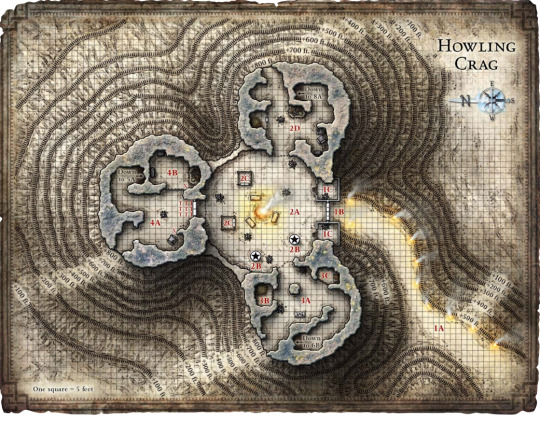
Man, map design in the 4e era was so fucking bad. It looks fine, but like, this is four circles. And downstairs is, of course, cave as far as the eye can see. Aren't stone giants supposed to be skilled carvers? Anyway, If you feel like G2 would be too big of a jump mechanically compared to G1, this exists. I'm sure you could use it if you liked, and certainly there is a Genre of Grognard who would be kinda tickled at the thought of finding "lost content" for el classico GDQ.
Next week, we cover G2, which was also in July. So was G3! They're triplets!
24 notes
·
View notes
Text
I'm not posting this on the sideblog because this is a little too spicy for chronotsr but like, reading through the ADND DMG makes me wonder how the rpg hobby survived Gary. This is one of the worst rulebooks I've ever read on so many metrics.
It's unclear. It's unpleasant to read. Gary is pointlessly mean to both the reader, his competitors, and your players constantly. Important rules are hidden in walls of filler text. Rules are located in inscrutable places. Unimportant rules will be multiple pages long, critical rules will lack any detail. Internal logic of rules ranges from headscratcher to hair tearing nonsense.
Genuinely, ADND is some of the worst rules I've ever read. It is no wonder that B/X clones rapidly out-competed ADND clones: they're better. B/X was just better. And yeah some of that is weapon's grade nostalgia for your first DND game in B/X, but I think all demand for ADND is Simple Rick Helmet-tier nostalgia questing. There is...just no real reason to run this game other than "because I used to". Even OSRIC is an extreme improvement despite aiming for 100% compatibility. That 100% compatibility isn't even in the cards is nuts.
0 notes
Text
No. 9 - T1, The Village of Hommlet (August 1979)
Author(s): Gary Gygax Artist(s): David A. Trampier (Cover), David C. Sutherland III Level range: 1 Theme: Tutorial dungeon Major re-releases: T1-4 The Temple of Elemental Evil, The Village of Hommlet (2009), Original Adventures Reincarnated #6.
CW: Discussion of Antisemitism. I didn't see that coming.
Possibly the end of the hiatus curse? Since then, I had further brainworms and acquired (and read) the fiend folio, the MM2, several Jon Petersen histories on TSR and the industry, and more. Will this reflect in the review itself? Maybe!
...Wait, there's a 4e version? 4e had a really weird habit of random 1e remakes didn't it? It was a reward for WOTC's organized play DMs, I have not read it in its entirety but it is very revisionist in a bad way. It's jarring, it mashes up 4e-style art with the original black and white pen-drawn art of 1e and also greyscale realistic maps? It's a mess of a release and there's some truly weird retcons in it. Anyway, we're here for 1e, not 4e.
Actually, one more aside. There is an adventure sequence called The Great Greyhawk Campaign. It was never officially announced or released as one product, but the idea goes that you start in Hommlet, you go to the Temple of Elemental Evil, you do the Slavelords campaign, then the Giants sequence, then the Drow sequence, and finally wrap in Q1. That's a hell of a ride, and it would probably comfortably get you to level cap for most characters. I really wanna try it some day, but I can't imagine it ever happening (that is SO long!)
So. T1. How do you start with T1?
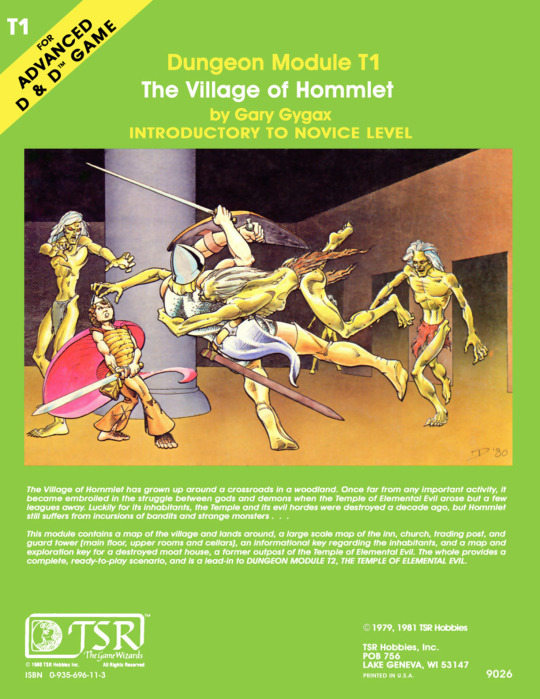
I think you can seriously argue that T1 is the single most reviewed module of all time. It honestly feels a little excessive to cover it. And yet, I felt obligated to do my dues to T1. Why?
Because T1 is, more than any previous module, the most influential module ever made. Lots of early modules are influential. G1 is important for being the first standalone module. D2 is important for being an early module to not assume hostilities. B1 is the first tutorial dungeon. But the thing about all of those is that in 2025, those types of modules have dramatically moved on. T1 remains the same. T1 is the granddaddy of all starter towns in every video game and every ttrpg. Every starter town is being compared against T1, it is the baseline.
Now this is not to say that T1 is perfect, or that T1 has aged like fine wine. But T1 tapped into something elemental about D&D that it needed to progress. Prior to T1, many parties simply...didn't play out the out-of-the-dungeon part. Characters poofed into the dungeon entrance and poofed out because the game was about dungeoncrawling. T1 represents a wildly different vision for the game, one that Gary and friends had been doing for a while and many people had independently dreamed up, but T1 made it standard that there was a nearby town that you actually went to and played things out, that was your home base. D3 was still, ultimately, a hostile environment. Like look at this:

That's just what DND towns look like. This basic structure (a town with a mayor and farmers and shopkeeps and blacksmiths and the local wizard and a dungeon nearby) is ubiquitous in DND now. You can basically describe any given dnd starting town as Hommlet And BLANK. Orlane is Hommlet And Kidnappings. Phandelin is Hommlet And Miners. Shadowdale is Hommlet And Wizards. Saltmarsh is Hommlet And Smugglers. It's hard to even get across how little has fundamentally changed between T1 and the 2014 Starter Set. Really if one thing has "changed" between T1 and then, it's the belief that adventures SHOULD have narrative hooks and SHOULD have an overarching plot. Even then they sometimes skip those.
Despite it's influence, T1 is weird in that it feels less like a module and more like a game aid. At its core, Hommlet is a town that has nothing to do with the nearby dungeon, and a dungeon that has nothing to do with the town. The town is keyed like a dungeon, and the dungeon is keyed like...a dungeon. The connective tissue is that the Temple of Elemental Evil is lurking as a threat behind everything, but T4 won't be released for QUITE some time, so it feels vague and distant. We get an actually surprisingly sophisticated history lesson: Hommlet was founded as a travel inn, a blacksmithy, and some farms. It grew into a proper town. Things got bad when their neighbors in Evil Town decided to Worship Evil and did Evil Stuff to them. The forces of good rallied and killed the bad guys, sieging the Temple of Elemental Evil and locking the evil inside. Adventurers slowly dried up as the area ran out of adventure to adventure at. So now evil returns and you lot will bumble into it.
Let us, then, get into the town part of the key.
One of the cliches of old TSR towns, to me, is that item #1 is always a farm. The game always presumes you enter town and you find a farm and the family is there and they wave at you. Orlane inverts this a bit by having the farmers NOT happy to see you, which is one of the many reasons I consider Orlane to be the most interesting starter village ever.
At this point time, thieves are a class now, and so (conspicuously) everything is marked for how the players could rob it.
There are a lot of what you might call "empty hooks" lying around town. For example, the son of a local farmer is actually a spy for Verbabonc (SUCH a TSR name) that will help you if paid to, and if he dies his brother will demand restitution. Why? That's left to a later module! Which wouldn't come out for another 6 years! Oops!
The wealth amounts in this town are genuinely unhinged, as usual. Inside a crock in some cowshit is, for some reason, nearly 700gp of treasure. Would you go digging around in cowshit for 70 dollars? Maybe if I had gloves. The placements are all nefariously difficult here: "sewn inside a horsecollar" do kids even know what horsecollars are anymore? Do they know who Horace Horsecaller is? How old are we!
A frankly annoying quality here is that these buildings are keyed with the first appearance in ALLCAPS followed by the actual building title in the body paragraph -- The Inn of the Welcome Wench is buried 3 lines into its text. You're not gonna skim that. You have to know in advance where it is, basically. The inn itself is, inexplicably, keyed separately without calling out that the actual room-by-room is elsewhere. If you scroll forward to page 9 (possibly looking for the map, which is also housed elsewhere), The contents of the inn itself is fairly ho-hum, it's a normal inn with many normal recruitment opportunity and the obligatory gygaxian traitor henchmen (who are unfailingly higher levels than their non-traitor peers). A few specialties are here though: a secret room from the old resistance, a spy from the temple of elemental evil, a secret ceiling compartment where druids can spy on suspicious guests).
A cavalcade of repetitive cottagers follow, emphasizing why in the future we stopped keying every single house. Many are not named, with that classic "so you customize it" excuse that people love trotting out. It does serve the purpose of making sure you have an answer to exactly who is with which faction: The Cuthbertites, the newbie; The Grove, part of the old alliance; the Temple, Verbabonc, the big supporter of the alliance; or one of the few neutrals.
The trader's establishment is also lovingly given a map and keys. Curiously, it is for lack of a better phrase "sub keyed", where the main room has every single item in it given a location. The map is here mainly because the players might discover the traders are also spies and want to kill them. They probably won't succeed, it's a Lv10 thief and a Lv7 assassin, they will at best cause them to flee and at worse die in the process.
I always find it funny how "moneychanger" is a perpetual occupation in DND. I have no idea how common historical moneychangers were, but if DND is to be believed, there's one in every podunk town. What do they do for the majority of the year when it's not market day?
For reasons I cannot fathom, they finally call out the separate map and key for the church after skipping every other keyed location. It's a standard fantasy church, styled after a catholic one, with the bit that Cuthbert is a brute and likes beating his worshippers into compliance. It's trying very hard to be funny but I'm not sure how funny it'd be to any table I've run. Why precisely this needed a room by room map is unclear to me, I can't foresee why you'd fight there. The walled manor is not keyed, despite being the official holdout if the temple attacks.
A half-built castle is underway for the town's old heroes, Burne and Rufus, who are mid level adventurers who have settled down. They live next door in the tower, which gets its own key, though there's not much to report beyond "it's a guard tower." Really, the main advantage of T1 as a document is that it has maps for your default buildings: a town, an inn, a trader's shop, a guard tower, and a dungeon. The maps are probably worth more than the keying for the purposes of the neophyte GM.

It is truly the town-est town ever to have town'd. Its genericity means you really could just put it in any faux medieval fantasy setting anywhere.
Nothing's really driving you to the main dungeon, that moathouse, in fact it never directs you to mention the moathouse from any specific NPC. You either work it in or the players need to wander around and explore it for simply being there -- like you're playing a TES game. In fact, not much of this book's setups really fire off anything else. There are a few people who will tail you into the dungeon or betray you if you hire them to go in with you, but that's pretty much it. All the actual secret going on in this town is immaterial to T1, setting up for T4? But let's talk about the moathouse.
First of all, I just adore the bad guy's name. "Lareth the Beautiful." They really don't make NPC names like they used to. A good title after a first name -- even just a place of origin name (Bridgette of Freeport) starts implying things about the world that are far more interesting that Jane Silvercat. A pox on noun-noun names! It's almost a shame Lareth will probably die here because he begs to be put to greater use! In any event, the Moathouse is a shithole. Just look at this mess:
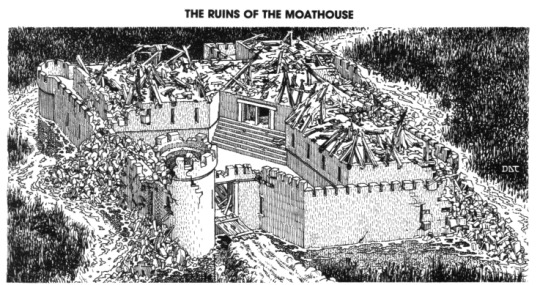
Your first instinct when you're reading about the new castle is "why don't they just repair the moathouse?" and you see this mess and you go "oh yeah that makes sense." There's not much to say: it's a moathouse the Temple of Elemental Evil built as an outpost. It got destroyed when the Temple got shut down by the big alliance, and now it's despised and destroyed. It's faintly defiled land. Really the weird thing is that it's a full hour away in a marsh. I will spare you the Monty Python bit.
Going into the keying now:
The random table is interesting in that half of the encounters are actually not encounters at all, but rather random happenings. It's a messed up castle so it's echo-y and there's rats and it's still in the process of falling down.
There's something so simple about being jumped by frogs at the front gate. I always love the "drag the player by the frog's tongue" moment and I use it often in my own games.
This dungeon is working hard to communicate how messed up it is. Even the floor will give in on your mount, laming them. Mercifully, there's a chance of discovering bootprints to confirm you're not alone.
The bandits inside have a solid escape plan, and will use it if you look scary: bar the door and run through the hole in the wall into the marsh. It's nice to see clever bandits sometimes.
Not unlike Saltmarsh later, the top level is mostly deserted. It exists to get you off guard for the actual danger in the dungeon level. Physically accessing the basement is fairly easy, there is 1 access that you simply walk into from the big room, although a sister staircase gives you further reason to look for it.
The bottom level, by comparison, is just very stereotypically dungeon-y. There's torture chambers, miscellaneous monsters there through hiring or chance, torture chambers, et c.
The false door trap is so beautifully simple that I'm a little surprised it hasn't made more returns. Essentially a common door that, when opened, closes a portcullis behind the door and reveals a dead end on the other side. It's basically just a loud cage snapping shut. So many traps make no sense but this one is surprisingly simple: it's a gravity powered trap, controlled by a disguised winch elsewhere.
Tragically, Lareth's ambitious do not get much detail. He's the new hope of the Elemental cult but how or why he does this is not clear, just that he's underhanded and clever.
A strange and gross final note to end on: one of his pieces of loot is a phylactery, but not in the Lich sense -- it's an amulet-amulet. That you wrap around a cleric's arm. In fact, Lareth is specifically wearing it on his left arm, which strongly implies he's right-handed. I think this because, when Jewish folks wear real-life phylacteries, they wrap them around their non-dominant arm, and another around their head. Wait, so we have an evil cleric leading a secret cabal that is opposing a catholic saint by spying and infiltrating a community and leading monsters against them, and he is explicitly duplicitous and a talker and underhanded and greedy and in league with a demoness. The fact that Laerth is wearing the phylactery correctly implies that Gary knew exactly what it was. Gary, why did you strongly imply the evil cleric in charge of the evil cult of demon worshippers was Jewish? Gary, what the actual fuck? In hindsight, the bad jokes about Cuthbert scan as an inquisition joke, I was imagining a nun smacking a student with a ruler...
That's...a really bummer note to end on. I'm sorry. Next time, uh...White Plume Mountain, the funhouse dungeon? At least it'll be lighter...
5 notes
·
View notes
Text
No. 5 - D2, Shrine of the Kuo-Toa (August 1978)
Author(s): Gary Gygax Artist(s): David C. Sutherland III (Cover), David A. Trampier Level range: Average of 10, preferrably party size 7+ players Theme: Underground exploration Major re-releases: D1-2 Descent into the Depths of the Earth, GDQ1-7 Queen of the Spiders
I'm almost speechless. This is the most 1e module cover to ever have 1e'd. It is perfection. The way the combat is perfectly perpendicular to the step pyramid. The bondage gear fishman who has a complete fishhead so you 100% understand he's a fishman. Lobster mommy saluting the troops. It's just….it's what dreams are made of.
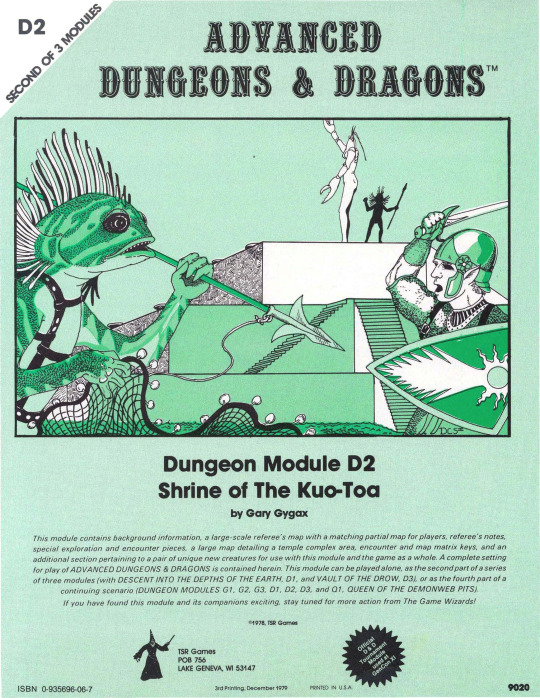
So I'm already in love with this module, deeply and irrationally in love with it, before breaking the cover. If you're BORING you might prefer the later Jim Roslof cover art that's got lame things like technical proficiency. Ugh. The shit I have to put up with.
Anyway, there's a lot to talk about with D2! It's a lot of firsts for an official TSR product, and critically it's a lot of GOOD firsts.
It's the debut of the Kuo-Toa, one of the most fun groups of people in D&D! It's the first module that doesn't presume the enemy will be inherently aggressive! It's got a lot of negotiation and learning! The only good type of gnomes debuts with the Svirfneblin! This model of "alien settlement where you are not instantly attacked but you gotta learn the social rules and play along" is just the best. This will be done again in U2 and I adore U2. Yeah it's how it feels to go to a different country, especially one that doesn't speak your language, and just have everything be a little "off" compared to what you're used to, but. To me, it will always be The Autistic Experience. How well and quickly can you learn these bizarro social rules you can't intuit and what's the fewest number of whacks to the head it takes to get there? How long can you swallow your complaints when you see stuff that's obviously cruel, but the people around you don't perceive it as cruel anymore because it's The Way Things Are and they will actively defend the cruelty of it?
Ok, ok, back to your regularly scheduled program.
Gary starts off this week's festivities by telling you to be toxic to your players:

Sometimes it feels like there's three Garys in a trenchcoat and they take turns writing the modules.
So D2 starts in the cave at the immediate end of D1 and, let me derail already by saying that I really, really hate old-style hex maps. I cannot follow them -- I don't mean I don't understand how you're supposed to follow them, I mean it's nearly impossible for me to follow the diagonal to the destination. Your coordinate here is R20. Here is your map. Follow the 20 axis diagonally upward and rightward until you intersect with the R row. Can you do it?

Personally, I can't. My eye cannot follow that straight line, it will get lost in the mix of blank identical hexes and occasional interest objects. I sat here trying to follow it for 5 minutes and I couldn't do it. I need a straightedge to do it. The correct answer is that if you follow the light blue area from the bottom right towards the top left, it's the hex up and left of the fourth fully black hex you run into -- the leftmost of the two touching black hexes. I tested this against a few guinea pigs and no-one else could mange it either. Later we will admit defeat and that this axial coordinate system for hexmaps is, uh, really fucking bad, and replace it with offset coordinates (or even better, double coordinates) which more closely resemble normal cartesian coordinates, and by extension are not Eye Strain Central. They have the downside of different eyestrain (tiny font) and that you literally cannot fit as many hexes on the page, but the point of a graphic is to communicate information and the axial coordinate hexmap is bad at that unless you're playing on a huge table with like, two DM screens.
Yes this rant should've gone in D1, mea culpa. In my defense, D1-2 is, basically one module in two parts, they're not really separable.
Here's the coordinate lined out for you, since I imagine many of you have the same issue:

So, now that I have a headache trying to read, we can get to the actual text of the adventure again. Now keep in mind that max movement rate is 1 hex per 1 inch of movement for the slowest member of the party (so like, your guy wearing platemail has 60ft of movement, 10ft to the inch: 6 hexes per day). This means you could hypothetically arrive at the final location as quickly as 22/6=4 days of gameplay, 3 if no one including hirelings wore plate. That is, if you beelined to D2 by sheer luck, never got lost, never got distracted, never got slowed down, never had to take a rest day. Which is good because the food in The Depths seems questionable.
The first segment of the adventure is mostly reprinted from D1 -- random tables and maps and the like. We do get the addition of everyone's favorite early DND trope: a slavery table! And also happilly we get some goopy guys to move your eyes away from that shit:
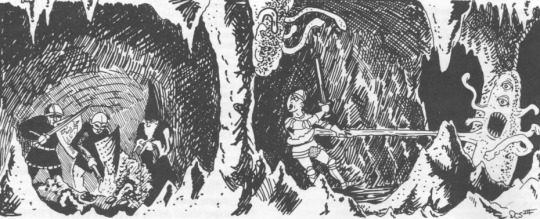
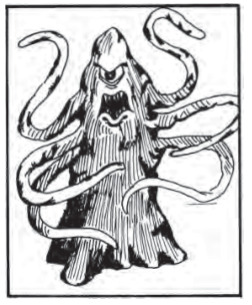

Which, is a lot more my speed. More goopy guys. It's a roper, actually, although I frankly didn't recognize it. It looks more like the monster from Dexter's Lab? Apparently Ropers have changed a lot in the last 50 years.
So it's all random tables teasing that we're going to end up arriving at a shrine soon. There is a special entry in the back for the new Kuo-Toa and Svirfneblin, and oddly the Svirfneblin don't get a header? We don't learn much. We know that they're natural elemental summoners, that they're "natural fighters", and that they live at some unstated cave somewhere. They like their stun gas darts, they "communicate with racial empathy" (which I guess means body language?) outside their own domains, deep gnomish at home, and underworld cant when they're trading, plus earth elemental-ese. So they learn a lot as kids. They love them some traps, too, basically they're the gnomish Rambos and I love them for it.
Meanwhile, our titular Kuo-Toa get a pretty standard write-up. Driven underground, human sacrifice, raiders, like their war parties. Their priests like their mancatchers, which are based on lobster claws, they spawn in pools, they can spontaneously generate lightning by holding hands (???), are too slippery to grab, can see both infrared AND ultraviolent, can see you moving through basically any magical means, immune to poison, paralysis, charming, sleep, and are resistant to magic missile and lightning. This is, very very weird. They are wildly powerful compared to their later versions, and the only upshot is that they're readily blinded by light spells. Apparently they go insane with such regularity that they have a dedicated social role to controlling or killing the crazed? Yeah these people are a piece of work.
We get a little setpiece moment here where, essentially, there's a rogue kuo-toa who will offer you a trip across the river for 10g. He only speaks kuo-toa and he'll sicc his giant fish on you if you don't say yes fast enough. In fact, a lot of ink is spilled on this little moment, which in all likelihood will be a brief conversation and some passing of money.
Before you get into the shrine proper, some svirfneblin offer to help you in the shrine if you go halfsies on treasure (with almost that exact wordchoice).
Finally, we end up in the shrine proper, which is keyed so let us enter Keyed Mode ™️
The whole area is lit by glow-in-the-dark lichens, which is a spooky way to reveal the lobster lady idol up on the pyramid
While the party can choose to politely integrate into the crowd and play along, there's lots of little things to harass them into nonconformity. Leeches, horrifying offerings, offerings of increasing amount, having to correctly pronounce nonsense names (Blibdoolpoolp????????), holding a live lobster, it's a good bit.
You can, in fact, visit the goddess, who will give you a boon (if you give an offering) or a geas (if you don't), which also grants you kuo-toa speech and also a mark of loyalty, which is neat. You can also encounter her if you fuck around in the prince's treasure room, so the odds of meeting her are actually pretty good! Note that this is pre-"Kuo-Toa believe their gods into existence" so in this case they are worshipping a (hypothetically) permanent, naturally-occurring deity. Being that this is 1e and she is a she, she is Extremely Naked. She is later called The Mother of Lusts, which is one hell of a title.
If you fail to get the priest-prince when you meet him, he actually has a pretty rock-solid escape plan and will come back with an army. So, probably whack him if possible. I really like when antagonists have the sense to piss off and come back armed, rather than pridefully stand and die. You get the sense that Va-Guulgh is priest-prince because he plans contingencies like this, whereas other Kuo-Toa simply vibe. That being said, the Kuo-Toa are apparently not equipped for a search, so it's pretty easy to ditch them.

Sigh.
We do not have a dramatic declaration of THE END anymore, which is a terrible shame. We instead get a more reasonable "This is the end of the section."
The magic of D2 is more in the play and less in the overview. Like, look at this map:

This is a pretty naturalistic map. This is just how you'd arrange a major structure, rather than the kind of nonsense layouts you see in a lot of early dungeons. I don't put much stock in "Gygaxian Naturalism", I think Gary presented pretty intensely game-y spaces and they only seemed naturalistic by 1970s published product standards, but nonetheless he was paving the way compared to some of the silliness you got in pre-G1 modules. This map is good, I think, in that it becomes super extremely obvious to the players from the moment you enter that they extremely do not want to provoke a full alarm -- this is a shrine where you want to kill as few Kuo-Toa as you can, and as many of those as you can behind closed-doors -- it's time to straight up bail if the alarm goes off because you are not beating the hundreds of guys here if you you provoke them up front.
We end with some rust monster art, my favorite monster that I never use because I think I'd get shanked if I did. See you next time in D3!

18 notes
·
View notes
Text
No. 6 - D3, Vault of the Drow (August 1978)
Author(s): Gary Gygax Artist(s): David C. Sutherland III (Cover), David A. Trampier Level range: Average of 10, preferably party size 7+ players Theme: Underground exploration Major re-releases: GDQ1-7 Queen of the Spiders; Dragon #298 and #300 (kind of), Drow of the Underdark (even less so)
Fuck I love old module covers. Again the later revision (the blue one) changes the art to be less gloriously trash, which is a shame. The cartoony sketch era is not long for this world, C1 (Tamoachan) represents a pretty noticeable change in art style towards the kind of THIN YOUR PAINTS looking characters in color. We have another year of modules before they make the art less silly.
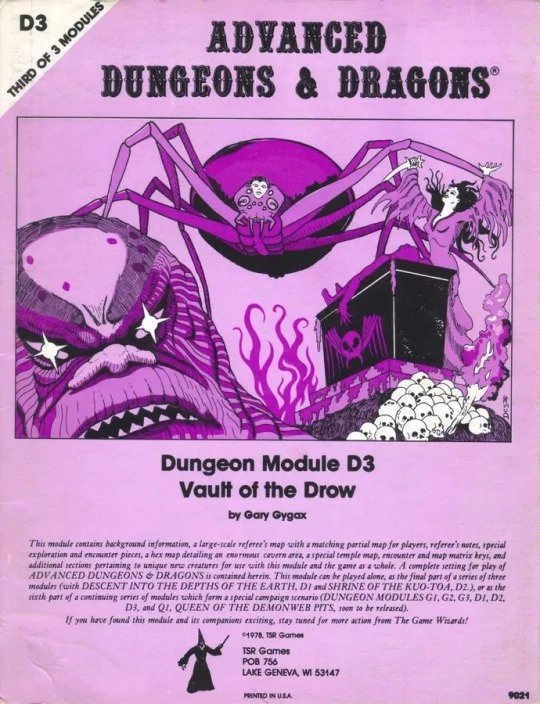
In re-release news, again we get a very lightly altered treatment in GDQ Queen of the Spiders. Less well known though is a section in Dragon #298 (immediately after Paizo took over) on the Vault of the Drow, although it is…almost entirely setting material, which makes it actually somewhat faithful to D3. What makes it unfaithful to D3 is that it takes place after the events of 1e/2e DND and doesn't contain any of the pre-Vault materials of D3 or the Egg of Lolth section.
Drow of the Underdark is a similar situation, but curiously uses totally distinct materials (like yet another map of the city), but contains even less information about the non-city parts of the Vault. Still, it's interesting seeing 3e-style treatments of D3, and if nothing else it gives you some damn visuals of what Erelhei-Cinlu actually looks like.

The module starts with a recap, and also a brief note as to how to get to the titular Vault of the Drow. Apparently you are now avowed nemeses to Drow, despite plenty of routes to the contrary. We'll also find out later that we're actually enemies to only one bloc of Erehlei-Cinlu Drow. We get the same list of warnings as the previous 2 modules, which themselves contained a lot of warnings from the G series, so this is our 6th time reading some of these bulletpoints. Strangely, apparently "because of the chaotic nature of the dark elves", active raiding parts of the town won't rouse organized resistance to the party, Light spells don't work right here (they go dark and brownish), and Drow resent even the slightest natural-ish light. The upshot is that you can get away with a lot of bullshit.
Our random encounter tables have been updated to reflect being past the main Depths foes of kuo-toa and the like, it's mostly Drows and monsters from this point on. Well, and undead. And bugbears. And trogs. And trolls. And slaves, of course. So mostly just that Kuo-Toa are gone? Svirfneblin are listed with the random encounters despite not actually being on the random encounter list? Anyway.
We have a few canned encounters.
The first one is, suspiciously similar to the Drow checkpoint in D1. It's basically the same. I'm not going to cover it again, it's just the D1 checkpoint but with the weird Battle of the Sexes angle removed.
The second one is a bizarre encounter -- a succubus is pretending to be a statue, a Drow vampire is glamored to look like a songbird, and the whole cavern is glamored to look like a beautiful grove. The vampire is, obviously, named Belugos, because fuck it why not name the vampire Bela Lugosi? They're gonna do their level best to make the players turn around without fighting, but the odds of the whole party failing the charm person AND not finding this suspicious is 0%. Their mesmerized gnome servant completes the Dracula reference.
It's passingly mentioned in their treasure notes that, Bela Lugosi lead-lined a box to hide magic items from magic detection. So that's our newest data point in the "we have to have rational explanations for magic" series.

I guess she always goes nude. She's also nude on the revised edition back cover, which I'm sure got someone in trouble with their parents in 1985. This is one of your two possible routes into the Vault, by the way.
The other way is through a giant spider trap. The only thing of note is the idol of Lolth you can find that gives you a variety of neat powers (but slowly turns you into a giant spider).
In the vault proper, we have some fun special qualities. Everything is simply a different color here, for starters -- modified by your vision type. The ceiling is literally a kind of radioactive parody of the heavens, complete with "stars" and "moons" being played by particular types of rocks and lichens. Everything's got a vague red hue, except the roads which are enchanted to be lightly blue to drowish eyes -- that's what those magical glasses from a few modules ago do, they help you see drow-enchanted markers.
The place is lit with growing shrooms, for all the light that'll give you. A lot of the random encounters give us little glimpses into drowish life, from the lumberjacks clearing fungi for food, leather, et c., to drow nobles on a hunting party, to merchants feuding, to kuo-toan spies lurking in the river.. A good amount of love went into these tables, which I really wish was the norm. "There are bugbears, they have these items and this leader" is a pretty lame encounter good only for punishing slow moving. That being said, this adventure loosely implies Bugbears are Polish? What?
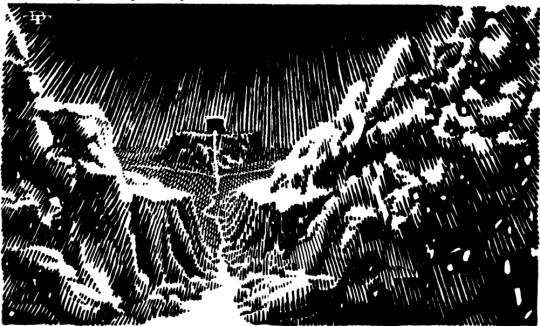
D3 is actually super sparse on artwork, and this is the best one we're going to get all module. This is the Black Tower, which overwatches a chokepoint to everywhere in and out of the Vault. If you have a drowish medallion, you can just saunter on in, enjoy your Evil Elf TSA checkpoint experience, then go about your business in the Vault. The medallions are coded by noble/merchant house, which means that your party just automatically became affiliated in a highly partisan city! Woe betide you, sucker that approached the tower openly hostile, cus they're guarding it with the GDQ series' perennial favorite: hand ballistae, and if you linger around the tower when the alarm goes off Gary straight up tells you to declare Rocks Fall, Everyone Dies because 300 drow troopss show up. Very cool, Gary!
So this is when D3 gets Complicated.
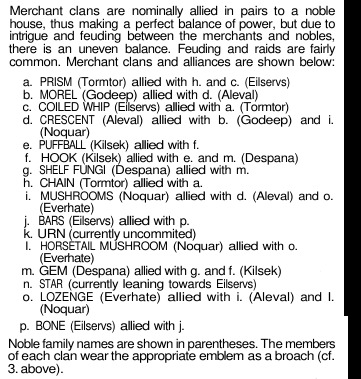
The best part of the Drow are is how much they plot. The worst part of the Drow is how much work that plotting is to run. 24 different families are all circling around each other, looking for weaknesses, allying and warring with one another. I think you would literally need multiple relationship maps to keep them all straight. The above list is actually only about two-thirds of the total relationships between houses, the rest come later with the noble house keys.
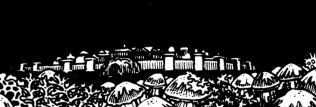
So, this tiny picture is the only visual we get of Erelhei-Cinlu. Well, that sucks. OK, well, let's presume you don't go in through the front gate, because that's obviously suicide, what then?

I'm sorry, what? The doors automatically sense your race and summon a demon with no ability to disarm? Fuck off, Gary. You have to go through the Black Tower. You have to get a medallion. You have to go through the Front Gate. You have to fight Lolth instead of the Elder Elemental God. Fine, I go through the front door.
E-C's description is exhausting to read because it's one of those times Gary just vents his orientalist, misogynist biases. Women are in charge? The men aren't buff?? There's sex workers??? Get me my fainting couch!
A lot of ink is spilled on the treatment of slaves, half-drow, non-drow, et c. Tragically the actual appearance of the city is not commented on very much beyond "it's very mazey" and "it's dark". E-C is perpetually 5 seconds from collapse at all times, but also hilariously stable. RIP to anyone dumb enough to rebel here.

Understandable.
E-C's section is a fairly rote "city that sucks" so let's move on.
Ah, the Noble Houses section. There is no way to put this gently, so let's rip the bandaid off. This is so much information that it's overwhelming (8 noble house houses with equipped npcs, special magic items, motivations, room counts, et c.) but also so little information about each individual house that you're going to have to heavily homebrew huge chunks of content.
For example, the first listed House is Tormtor. We know they're:
Rank 7 in the Nobility Hierarchy
They've bought off the head of the Male Fighters' Society.
Allied with Eliservs House, the unnamed Prism and Chain Clans, & indirectly to the unnamed Coiled Whip, Bars, Star, and Bone clans
They on the up and therefore unpopular with the other nobles
Have 6 unnamed nobles ruling the house
Have 6 named and 7 unnamed magic items.
But…what is special about this house? Why are they so ahead? What does their palace look like? Why would you go to it? How could you possibly interact with the alliance and enemy system, as a non-drow?
These descriptions are just not useful, and by the time you have written out enough information on all 24 families you have made the actual module into a footnote. Those later write-ups of E-C can't save you either, because the timeline advanced.
By reading the whole thing and taking notes you reveal that there are two blocs (the Tormtor-Eilservs bloc and the Despana-Kilsek-Noquarto bloc) and a handful of neutrals waiting for a clear winner to back.
The Eliservs are the first rank house, headed by Eclavdra, and their big plot was pivoting from Lolth worship to Elder Elemental God worship because the Lolth priestesshood didn't back Eclavdra's claim for Queenship. Remember Eclavdra? The text explicitly says that if she died in G3 she was cloned (eyeroll) by her consort. Why organize the events of the G series? To get more EEG converts and attain Queenship. An extremely risky plan that we will discover in T1-2 and A1-4 is more plotholes than plot.
Like,
Eclavdra's house is about to fall before you showed up.
She's in charge of the Giants
Eclavdra's fall would signal an end to the Giant incursions
There is no longer a reason to deal with the Giants
There is no longer a reason to deal with the Drow
There was no reason to do any of this
The EEG temple is actually the one from G3, so you've even already punished the Drow before D1 even started! And also, how exactly is that possible? The route to the G3 temple and the route to D1 are 51 miles apart?
I have read quite a few suggestions on how to un-fuck GDQ, and my personal preference is this:
Flip every House's religions, EEG to Lolth and vice-veras
The Giant plot is Lolth's, and Eclavdra's sister is acting for her
Regardless of G1-3, Eclavdra is about to win the secret war for Queenship via the Lolth cult.
A unified Erelhei-Cinlu is a threat and must be stopped
Anyway, having now shredded the politics in here, we move onto the dungeon-dungeon.
First, the Egg of Lolth, which is the broader Lolth zone in Erelhei-Cinlu. Yada yada yada spider sacrifices, orgies, et c. It's all very rote. The head priestess of the lesser temple (not the greater temple!) has a lot of money but not so much magical items -- a weird quirk of D1-3 is that there are basically no magical weapons, so your fighter is probably livid by now. Then, we enter the Great Fane of Lolth, which is to say the greater temple. And we will go into keyed mode:
The temple itself is pagoda-themed, in case you haven't guessed that the Drow are supposed to be vaguely China-themed yet. Naturally trying to climb around and not dungeoncrawl properly promptly punishes you by being suddenly attacked by a giant pile of gargoyles and shadows.

Every depiction of Lolth, even from this second-release copy I'm using, is just….truly sad. Why was "monster but animal head" so common for so long? It's not scary or weird or funny, it's just lame?
The walls are decorated with fake halloween spiderwebs, so this whole place feels like Spirit Halloween. The actual Fane itself is weirdly empty?
Like an evil confessional, all the council chambers have secret spying rooms.
You run into a fake Lolth illusion who pranks the party, which is really not helping the Spirit Halloween vibes
If you walk into a painting of the Demonweb Pits, you just instantly die (or skip directly to Q1 if your GM hates you -- general consensus is that Q1 is bad and that you should just use the pre-planned D3 version of the Lolth fight)
Finally, as you enter the dungeon part of the dungeon (which is actually pretty small by late-game dungeon standards), there is a passive fear aura and all the spiderwebs are now made of onyx and silver, which means your party is going to have a field day with the chisel.
To my great shock and happiness, there is a drow dissident here! And he's good! And won't backstab you! He is neutrally aligned and wants to reform drow society. Good for him! There's a messed up enchanted silver cage which essentially magically webs a victim in a sort of metaphorical representation of a true spider enwebbing their prey. It's a cool visual!
Lolth just kind of, hangs out in room D5. She isn't doing anything. If you kill her, she drops an egg with plot items for Q1, and geases you to walk through that one painting. No save, of course. Lolth herself is a "hard to hit, high resistances, low HP" affair, but also she can heal herself for 50% three times a day, so she is triple dipping on difficulty (in this biz we call this "deeply unsportsmanlike" but I'll give a pass for a demon queen being bullshit)
There's no real reason to go up. Lolth is down and you have no reason to believe good shit should be up, but if you do anyway you will find a variety of random people wandering around with magical goodies, like the high priestess and the commander. It's implied the priestess has been fucking a demon?
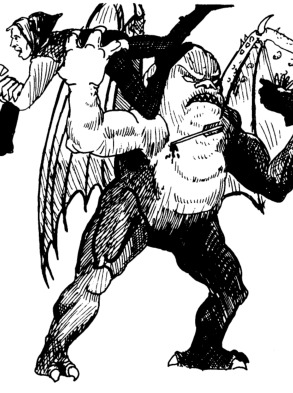
Your taste is a lot different than mine, ma'am.
Naturally the treasure room for the fane is hilariously trapped in like three different ways, including with permanent dust of disappearance. Inexplicably, there is a talisman of lawfulness that, if combined with some diamonds, tells you how to reach Lolth. Why was there a talisman of lawfulness in the treasury? Why does it tell you how to get to the demonweb pits? Why does it write in drowish runes?
Finally, you find a wharf with a boat in it. It's trapped with the previously mentioned sentient statue, but hey -- you now have a galley that you can only use on the Pitchy Flow, Svartjet, and Sunless Sea (in an unexplained way). Good luck with the 66 ghouls, 6 ghosts, and type 2 demon!
That's, that's it? Again, D3 reads like a tiny setting book larping with an obligatory dungeon at the end. The Fane is the blandest dungeon thusfar, and G2 was already pretty lame. Still, it is not lost on me that you could form an entire campaign in the Vault's materials, and it might even be good if you relax the "Drow are ontologically evil" quite a bit and allow your party into the factional fighting.
Next time, Tomb of Horrors! Possibly the most over-discussed module is actually a quite early one. See you then!
15 notes
·
View notes
Text
No. 2 - G2, The Glacial Rift of the Frost Giant Jarl (July 1978)
Author(s): Gary Gygax Artist(s): Erol Otus, Dave C. Sutherland III, David A. Trampier (cover) Level range: Average of 9, preferably 5+ players Theme: Standard Swords and Sorcery Major re-releases: G1-3 Against the Giants, GDQ1-7 Queen of the Spiders, Against the Giants: The Liberation of Geoff, Dungeon #199, Tales from the Yawning Portal
On the heels of being more impressed with G1 than I expected, will G2 be similarly impressing? Time to find out!
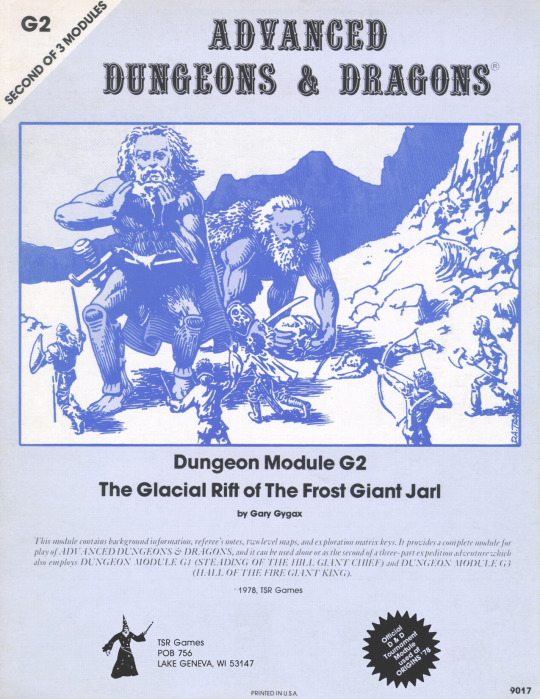
The intro blurb is mostly a repeat of the text of G1, including admonitions that running stock is for villains. Our motivation remains: figure out why the hill giants did that, no matter how fucking dangerous it is. Interestingly, the other main objective of G1 (give 'em a bloody nose) is not relevant here, because that teleport means that the frost giants aren't a threat to the villagers themselves. In fact, the room teleportation schtick kind of means G2 is filler? Like, the big reveal that the G series leads to the D series is not really impacted by the events of G2. So, oops!
Conveniently, the magical chain teleports out outside the rift so you can once again have a secret cave HQ. I feel like you have a responsibility as a GM to have a giant counterattack to at least one of these caves.

I really like the imagery of the descent into the rift here. I mean, I don't think this illustration really does it justice, imagining the deep blue color of light barely passing through the ice and how that gives the area beneath the surface an eerie oceanic glow at all times other than noon -- that's some good vibes. Gary opts for green, which is a fair enough choice. Unfortunately, Gary is more interested in simulating the mounting climbing than vibes, which means that at least one of your party members is going to fall face first into the snow drift below. Gary "generously" caps the damage at 10d6 (avg 35 dmg) -- a level 9 fighter, to be clear, has 9d10 hp (avg 45 hp) and a level 9 magic user has 9d4 hp (avg 23), so that's not ideal. Also recall that you recover 1hp per full day of rest normally, so if you fall and survive you're probably still fucked unless your cleric has a lot of spells left. I'm also pretty sure your cave HQ is above the cliff face, so, risking the descent seems like suicide to me. You're going to lose people and even leaving to heal them back up is simply taking another chance at oblivion. Take the stairs.
If you have the audacity to slow fall down, you will be blown 75ft off course in a random direction. Very cool Gary!
Another interesting detail: monsters in classic DND have a pretty short attention span and will lose you fairly quickly if you flee around a corner. This is particularly amped up here to a breezy 4 in 6 odds of success, due to blizzards blocking chase.
Anyway, we're into the room by room, so let's do some room by room shit.
There is a kind "spiked heads of our enemies at the gates" situation, with corpses mutilated and frozen in transparent ice as a warning to not intrude. Honestly that's badass. What's not badass is if the players have the wherewithal to try and free the corpses (for loot or kindness), most routes lead to the treasure being destroyed and the roof collapsing -- probably instantly killing your squishies.
The hill giants from G1 are lolling about waiting for an audience, so points for continuity. I have to imagine they're freezing their asses off, though.
There are yetis here? Which, going on the graphic and the listed intelligence score in the MonMan, I have to conclude are sentient bipedial apes but like, NOT like the Frost Giants. Actually apparently the average yeti is smarter than the average frost giant, so I guess it's a Diogenes situation where they choose to live in a shitty cave when everyone else has a nice cave?
The 5 hill giants visiting the Jarl have 1k to 6k gold fur cloaks, which like. Imagine a 6,000 gold cloak. Not only is it got to be huge (Hill Giants are 10.5ft tall), for it to be worth 6k to a vendor that's got to be a one-piece fabric cloak off a particularly rare and good condition animal. I guess the players could use it as the world's fanciest comforter?

The official appearance of a Remoraz! These are awful creatures. They swallow you whole and then superheat their insides to cook you. Nasty side effect: its outsides become furnace-hot and destroy nonmagical items and burn people to death. Look at this horrible thing! And of course it's guarding the swankiest loot to date -- a +2 Giantslaying Sword and a 3 Wishes Ring. It's been a weird trend lately that the best loot is, not owned by the leader of the Giants? The best hoard seems to always belong to Some Guy. Naturally this awesome loot "sinks into the ice" if you use a fireball, because this adventure has an addiction to telling the wizard to fuck off. Note that the sword being lost punishes the fighter for the magic users' decision. Note also that the Remoraz going into superheat mode doesn't do the same thing? It sucks. This clause sucks. Cut it. The actual room itself is kind of neat, the implication is that the Remorhaz melted a spherical hole into the ice to make a den, which is awesome.
Another iconic Garyism: ". They have had audience with the Jarl, and after a special wassail to be held on the morrow they will depart for home with a treaty scroll." Translation: They're goin to have a drinking party tomorrow to celebrate a treaty signing.
And like, one room later, we get "leman", which means lover, and "durance vile", which means long imprisonment. The text implies that basically, she's a hot butch storm giantess being held in chains until she agrees to fuck the Jarl. Gary, simply ask a tall woman out. You don't have to be weird about it.
Rather than torches, the feast hall is lit with jarred fire beetles, which is kinda cute
There is a thick iron bar that "transports whosoever is standing on the floor to the entrance of Snurre's Hall [G3]". The iron bar is a lever, obviously, but is this a lever-operated teleporter? An elevator that goes straight down? G3 eliminates the elevator theory, since apparently you can arrive here via pegasus and there are caves one can access overhead. So it's a literal teleporter, and at least how I'm reading it makes it sound more science fiction than magic. Weird.
On the whole, G2 is a massive step down from G1. G2 lacks the factionalism of G1, punishes players for damn near anything attempted, and is broadly less imaginative than G1. It's a pity, really, because it's a far more interesting locale on paper, but the reality is that you could generate a cave like this by scribbling randomly. Meh. Next time we poke G3, and hope hope hope that it's more like G1 than G2.
17 notes
·
View notes
Text
No. 3 - G3, Hall of the Fire Giant King (July 1978)
Author(s): Gary Gygax Artist(s): Erol Otus, Dave C. Sutherland III (cover), David A. Trampier Level range: Average of 9, preferably 5+ players Theme: Standard Swords and Sorcery Major re-releases: G1-3 Against the Giants, GDQ1-7 Queen of the Spiders, Against the Giants: The Liberation of Geoff, Dungeon #200, Tales from the Yawning Portal
So that was a little disappointing. But maybe it just middles in the middle? C'mon Gary, let's see that special skill I've heard so much about.
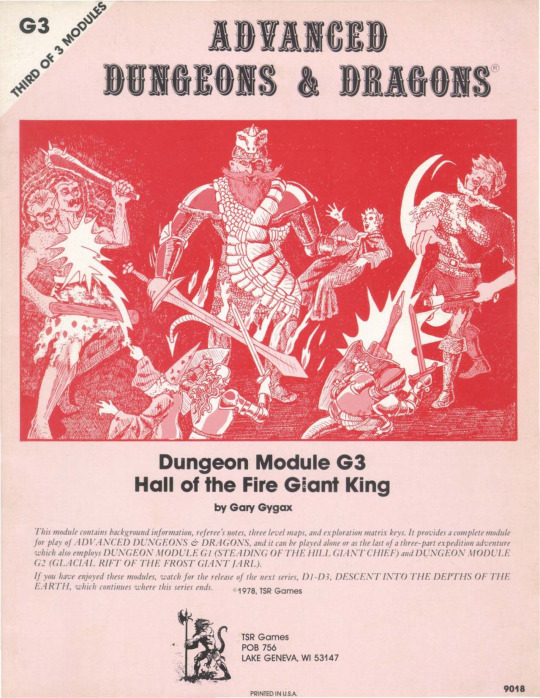
G3 begins how G2 ended: teleporting conveniently on the outskirts of the fortress in such a way as to skip a trek without surprising the players. Meh. Our big bad this time is King Snurre -- I haven't mentioned the Chieftains yet because they're all just midbosses compared to the this guy. And, he's kind of famous isn't he?
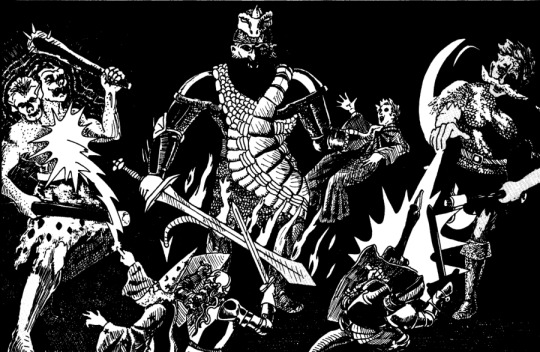
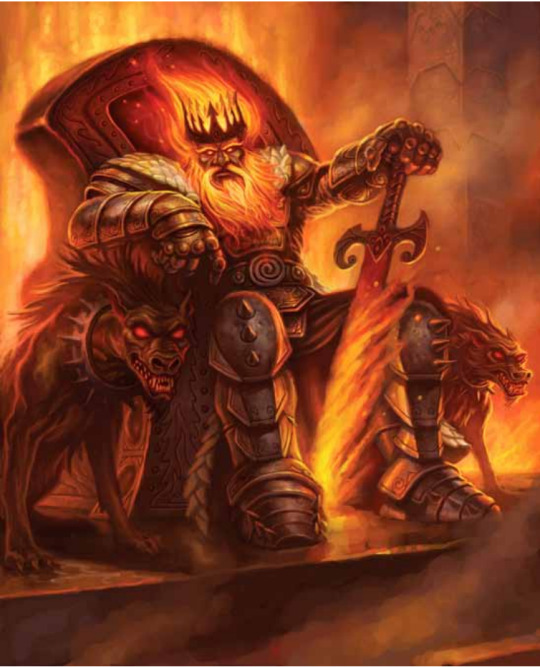

For a guy who is functionally a one-off NPC that the party presumably kills, he ends up in a lot of paintings. Not that I'm complaining, that 4e art is amazing. In fact, broadly, 4e's art is a little underrated, it benefits from being less restrained than 5e. I don't think that's a knock on 5e's artists, more like…the art direction seems to be intentionally tamer. Anyway, thank you 4e art, I never realized there was a dog in the background of the 5e PHB until now. Neat.
Yada yada yada the setup is exactly the same as before, but now it's got ~mordor vibes~. As far as changes change, these fire giants (even the children) expressly do not do morale checks because apparently Snurre is such a motherfucker. Scary!
Anyway, we're already in the room-by-room, so let's begin the juicy part:
There's a scooby doo trap with a tapestry in the doorway having holes for eyes so a giant guard can alert the entire building if the players don't catch it. That's evil! But not unfair, which is a good balance. Naturally, there is a ballista tripwire on revisit that does some nasty damage, so this hallway is just The Troll Zone
Snurre has two pet hellhounds leashed to his throne, but also he's wearing a white dragonskin as a cloak at all times, which overcomes his natural aversion to cold with MAGIC. What an asshole! Also, as you look at that picture from the 5e cover, there's a bevy of (unimportant) changes from the original, like Snurre is no longer in his signature pitch-black platemail, but I think special mention should go to the fact that in the original he has literally 60k worth of precious stones on his person and scattered throughout the architecture of the throne room. This room should be GLEAMING.
A Gygaxism: Queen Frupy is a 'haradin', which roughly means 'scold', which. Ok. So, so much attention is given to how uggo she is (to Gary). Actually, I think the description of her armor is kinda cool, she wears black dragonskin, studded with iron (so by Runescape logic I guess she's good with a bow?). Reaper Minis did a character that sort-of resembles the description, but their Vanja has a spear where Frupy uses a scepter:

You can actually negotiate with her, the implication of the text is that she's unreasonable but…just ignore that. Lol.
She also has a magic mirror (implied to be a furniture mirror, not a hand mirror) that reveals invisible creatures in the reflection, which is kind of awesome. Good way to catch assassins! Somehow the drow are using a gifted necklace to spy on them, but I feel like the mirror probably should've revealed in some way (maybe the mirror was also a drow gift?) She's more astute than she lets on, because she has a huge stash of mind control crap in her dresser drawers for emergencies.

????????????????????????????
Keeping with the "giant leader's treasure sucks" tradition, Snurre's treasure is genuinely crazy. It occupies a FULL PAGE, and each INDIVIDUAL TRUNK has a listing and an explicit mention of the traps. Traps range from a standard scything trap to secret snakes to the treasure being invisible to contact poison. How the hell does Snurre use this room? You're telling me he never fucked up remembering which of the 13 chests were trapped in which way? Oh, also, they're pick-proof, because fuck you thief. Naturally, the loot itself is also a fucking trap, because while there is some truly amazing stuff in there (20 randomized magic items, a decent amount of valuables, a +3 ring of protection, and a ring of 3 wishes), there is also lots of troll items (statues with a stacking curse of -1 to all tests, ring of contrariness, ring of delusion). On the whole, a big fuck you to the party. Oh, and while the locks are unpickable, you can shoot them off with magic missile, which is…why?
Snurre's dwarf-slave-advisor is bizarrely well equipped and loyal, and given the opportunity to escape he will…backstab the party. As much as people complain about how early DND has too many save or die traps, I genuinely think the regularity with which rescued npcs betray the party is a waaaaaay dumber and more ridiculous trend. I simply cannot fathom why someone as smart as Obmi would choose to keep being a slave to Snurre when adventurers showed up with the ability to free him. Honestly? Take his big lie and make it true. The lie makes sense because it makes more sense than the canon character.
The scroll that finally tips at the motivation of the giants is, no kidding, scroll #68 of almost 450 paper items, none of which are mentioned. The weird need for a number baffles me.
The kitchen is doing some lateral thinking and using one of the gas vents as a gas stove, which is hilarious.
Oh, we're only now to level 2?
All of the former kings are entombed in a Giant Tomb, which, that is entirely too cool of a visual for them to have not included a visual. In a fucking grave mistake, this room is cut from the 4e remake, so there is no incredible art of it. There is no justice.
If you somehow didn't kill the hill giant chieftain AND you didn't get him in G2, he's here in G3. And he brought the pet bears!

Gary, you're such an asshole. No one would ever think to throw their cool mace into the lava pit mid combat. This is just trolling.
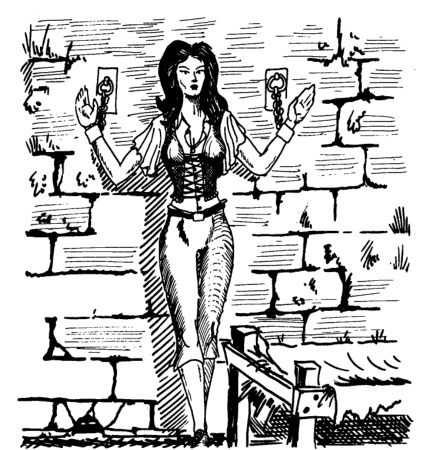
🤷 Guess I'll die
"The were-rats, if losing, will turn into rats and flee down the drain" That is, actually an incredible escape plan, except that we have pre-established that this Hall is founded upon LAVA AND COOKING-HOT GAS.

Fuck the party I guess
You often hear people who got into ADND in the late 1e/2e era talk about how people speculated that Hommlet must lead to Temple of Elemental Evil because of hints about the Elemental Eye and, honestly it just kind of feels like Gary defaults to the Eye. It has come up in every scenario he has written so far (which admittedly is 2 so far), but with the power of Knowing What Comes Next I can assure you that this is going to keep happening. Anyway, there is a temple to the Eye here, complete with human sacrifice, and the allusion to tentacles eating people is already starting to signpost what we now know is true: It's Tharizdun. The Eye is Tharizdun. It always comes back to Cthulhus!

A lot of early players clearly enjoyed Poking Random Shit because if you decide to touch the Elemental Eye's altar and also play every musical instrument in the room, you get to make every person in the room roll on this table, AND also execute whichever player is nearest to the altar (no save). But, hey, you will suddenly get whatever you want most on the altar. If you are somehow dumb enough to do it again, there's a 1 in 12 chance you get a +1 in all stats, a 2 in 12 chance of something extremely bad happening, and a 9 in 12 chance nothing happens.

Would genuinely like to know how many GMs bothered following this instruction. It does teleport you towards the final encounter, so that's something.
An entire page is dedicated to disarming the tentacle wall magic trap, which to be honest looks like it'd repel a significant percentage of players because you either need an evil cleric or some good magic to dispel the wall, and the wall punishes the shit out of you for trying to disarm it. To be a mild devil's advocate, the tentacle wall IS super suspiciously placed (the shape of the room implies it's going somewhere), so at least it's not also super esoteric. If you DO bypass it, you are now the proud winner of the "discover the drow" award! Woah, elves but they're ontologically evil??????????????????????????????????? Truly novel! Eclavdra, head of the drow here, hangs out doing nothing in particular, and you may unceremoniously execute her if you want to bring her storyline to an unceremonious end.
The frost giants are here from last module, if they survived. They really want you to kill these kings!
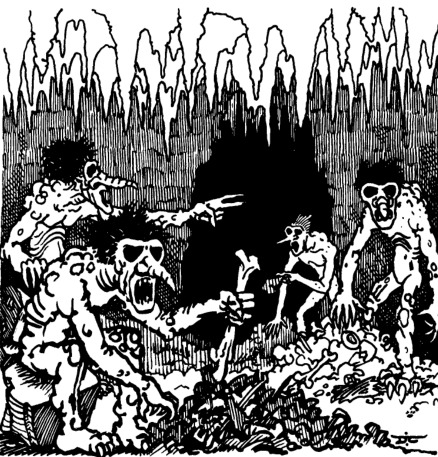
No really why did they used to draw trolls like that
This adventure just won't end. There's a surprising amount to say about this module given that it's only 22 pages of monster murder and motherfucker traps. Anyway, welcome to level 3!
There are fake dragons here to troll you into getting excited for loot
The fire giants also have a panic room? Every giant has a panic room. Why are panic rooms so normal in the G series?
A SECOND fake dragon that is actually a gorgon, which is almost funny
Finally, a REAL red dragon, which is frankly cruelty to fool me three times
After many, many drow are fought, you eventually run into a magic-fighter drow noble who has a wand of "viscid globs", which despite the suggestive name, is actually a superglue gun? You can literally rip yourself apart trying to separate yourself from a glued object. It's a really, really bizarre item. And it has a LOT of charges -- 79.
Mercifully, finally, something that could be potentially interesting: Eclavdra's rival is hanging out in the basement and can be sweetalked into helping the party screw over Eclavdra, which. FINALLY. However, if you displease her, it's demon time.
For reasons I cannot fathom, there are mind flayers here observing the drow, and the drow are not super bothered by that.
And that's basically it! at the very end they find a tube with a map and a wish leading to the D series, and a quick explainer on the then-new Drow. Well, not that quick, it's a page and a half, but the conceptualization of the drow is basically unchanged between then and now. Evil elves, forced underground, adapted to living there, dark skin, magic spidersilk clothes and adamantine weapons, sunlight sensitivity, drow spell list.
On the whole, G3 is, an adventure. While yes the Drow twist is kind of neat (but not special, since Drow are functionally Melniboneans and Elric was already decades old at this point), mostly this module lacks the fun of G1 and substitutes lots of murder traps for any genuine creativity with the scenario. On the whole, I consider it…crowd pleasingly boring? Your treasure goblins will love it for how much nice stuff they can find, if they survive.
We will end today with the back cover, which features some hippogriff mounts. People just don't give parties flying mounts anymore, it's honestly strange the tradition died. See you in the D series later. And if you're waiting for more obscure modules…I can only promise one in 1978.

15 notes
·
View notes
Text
No. 8 - B1, In Search of the Unknown (1979)
Author(s): Mike Carr Artist(s): David C. Sutherland III (Cover), David Trampier (Original Cover) Level range: 1, preferably party size 4+ players Theme: Tutorial Dungeon Major re-releases: Original Adventures Reincarnated: Into the Borderlands
A quirk of early DND that people sometimes forget is that you had to learn how to play this game. The assumption, prior to the Holmes Basic set being released in 1977, was that you knew a guy who knew how to play, in a kind of 1970s & Gary Gygax version of Six Degrees of Kevin Bacon. Holmes had obviously made a big dent in this, but still there were complaints about the game being confusing and hard to learn. In steps Mike Carr who made the following bold proposal:
What if we made a paint-by-numbers DND module to train new GMs with?

In 2024 you might scoff at this, because it feels an awful lot like they just sold you half a module and told you to finish that. This is an unfair read, but this is a genuinely good habit to instill early into a GM. Too many times have I seen a new DM just, run books entirely stock and then be confused why it went badly. This breaks the back of that habit very, very early.
For those of you that remain unconvinced, in the OAR re-release of Into the Borderlands they included three stocked versions of B1 (I recommend Version A). But: keep in mind! You could not tune into Critical Role, there was not a DND club at every major school, and the discipline of TTRPG design itself did not exist yet. This was a stab at teaching DND entirely via text, so we will see in time how good a stab they took at it.
Oh, and before I exit the intro blurb, let's say it explicitly: this is the first standalone Basic Dungeons and Dragons module. It was a pack-in with the Holmes basic set (which means you got the Tower of Zenopus AND B1, a pretty tidy bargain), alongside some depressing little dice chits, a little blue rulebook, and a coupon for some dice that are bad-in-a-highly-charming way. We are spoiled for dice now, back then you had to ink your own in CRAYON.
ANYHOW, let's begin.
Firstly, Carr begins with explaining some broad principles to an aspiring new GM, like the concept of keying, minions, xp, difficulty, GM arts, et c. He also recommends narrating the party as having already arrived at the dungeon, a conceit I think more GMs should entertain -- we all know that "we meet in a tavern" is a little played out, but I think it's played out mainly because it's done badly - meeting in the tavern served no purpose because the GM ultimately wanted to just hurry up to the dungeon.
The adventure proper starts with a quick blurb about two famous characters who in the wayback times built a stronghold, did some adventurin', fought some wars, but are now long gone. A separate account of this is included in the player-facing section (whatever happened to player-facing sections?).
We are given ol' reliable, a rumors table, where we learn very little of interest: The dungeon is called Quasaqueton -- a real place in Iowa, apparently the duo were slavers, and apparently the dungeon itself talks. It's generally wet and miserable here, and wandering about are a variety of very standard enemies (orcs, kobolds, trogs, rats). That's, basically all we get on the dungeon itself, so let's enter the highlights reel:
The very first thing that happens in the dungeon is simply adorable. Two magic mouths demand the party to defend their treasure-hunting ways, and then promptly tell them they're going to die oooOoOOOOooOoo! in a sufficiently melodramatic way. It also bugs you every time you revisit, which will turn it into a comedy on revisit. There is also the grisly remains of a previous party, as if to imply that these newbies are about to get HAZED. Given that this was likely the new GM and players' first go, I'd call even odds on it being a slaughter.
It is at about room V where I realize why roman numerals died off, as trying to figure out where room 5 is when there's many, many rooms with a V marking. Letters are preferable to roman numerals but truly it was a good day when we switched to circled Arabic numerals.
There is just something inherently funny about going into a wizard's closet and discovering that said wizard was a boring person with normal clothes and a bunch of mundane books about weather and plants. We also find out Zelligar has been absent for 30+ years from his closet-bookkeeping.
Teaching the kids early that wizards are assholes, in Zelligar's practice room there's a permanent illusion of treasure. It doesn't kill you like a Gary treasure would, it just makes you sad.

There is a weirdly elaborate table of jars? And one of the jars is a living black cat in suspended animation? The purpose of this room is, and I quote, "to surprise and/or mystify the adventurers, as well as to provide some fun for the DM". There is no treasure or monsters pre-stocked in most any of these rooms (as per the conceit) but I think it would be GM malpractice to not put SOME kind of fucked up jarred magic item here. That there is no potions in this room feels particularly odd?
There's a riddle in the wizard's lab that, isn't actually a riddle? It's just talking funny. Large swaths of this dungeon feel like they should be a funhouse and have loot pinatas scattered around, this is one such room. Instead, it's…just kind of a self-aggrandizing sign, like a weird motivational poster.

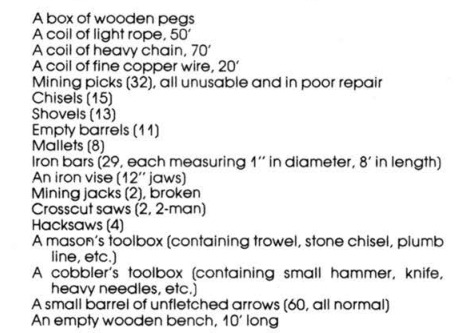

I know the conceit of the dungeon is that this is someone's home and stronghold but it kind of just feels like someone's Minecraft fort? I really feel like we're going to walk into a room full of chests contain 94 doors and 4,000 grass seeds any minute now. And I guess that food is 30 years old? The inscrutable letter codes make me long for a dAlphabet.
It feels kinda weird that fire beetles fell out of use. "Magic lightning bugs that infinitely fuel lanterns without igniting in swamp gas" is a super handy conceit.
We have a super classic portcullis trap with a elegant twist: because the lever to lift the trap is strength-based (sum of strength scores), it almost definitionally separates the squishies from the tanks. The downside is, unfortunately, that it's functionally a save or die trap despite not instantly killing you?

It's also really interesting how the fantasy of bending the bars went away. That used to be such a big thing in the superman tv show era. I have yet to have a modern player even consider it. Not surprising it stopped being in rulebooks though.
There is one of the regulation early DND troll traps, where a mapping party is to be intentionally tricked and given false descriptions because a doorway is also a teleporter. It is explained somewhat poorly, which is particularly unfortunate for a tutorial dungeon, but the jist is that once they pass through the doorway you should rotate your map and act like you haven't started describing rooms turned 90 degrees. Because early DND kind-of assumes the party moves as a blob while in dungeoncrawl mode, you can't get split up by this, despite the fact that "realistically" it would totally do that. A weird quirk of this description is that, I have no idea when they bold words. You think they're bolding for emphasis but it's acting like they're bolding keywords, but prior to this they only bold spell names and the bar-lifting. Afterward it's mostly spells and a sole keyword.

I'm getting mixed messages here. I get why it's here, but come on.
The coverart is a reference to a specific garden room which has overgrown in the wizard's absence. It is, ultimately, just a pretty room with a slight hazard if a random encounter happens there. "The room on the cover is inexplicable and unrelated to the rest of the dungeon" is funhouse-y behavior IMO, but the rest of the dungeon is a series of vaguely plausible rooms assembled in a maze-y way. Which is as good a segue as any to briefly talk about the overall layout.
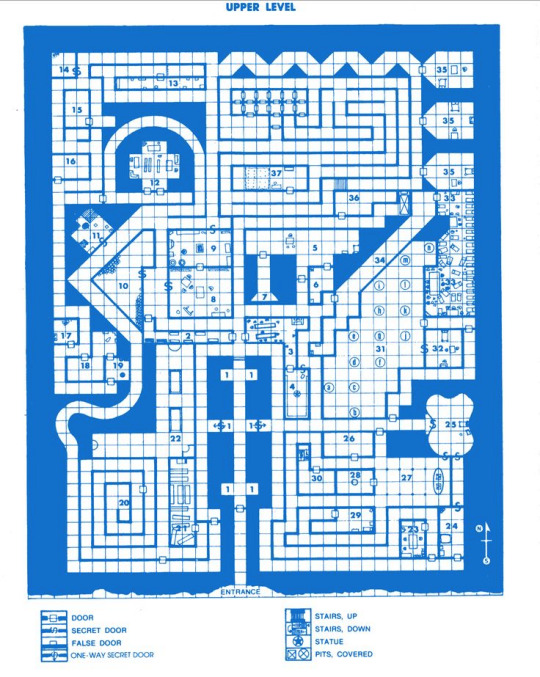
This is a bad layout. This is a layout you come up with when you are just procgenning maze dungeons over and over again. As we have demonstrated in previous posts, this is just kind of how it was in the 70s. This kind of works as a mapping challenge, but mostly it comes across as tedious for everyone involved. Who would make a living space like this? Even the most cooked adventurer on the planet would not install multiple maze corridors for…no reason? AND THE EXCESS OF SECRET DOORS. A friend described this as "a map you could almost make in Wolfenstein 3D", which is actually a great metric. If I can make your map in Wolf3D, it's bad.
There is a genre of dungeon room I like to call "gambler's traps", which is when the room contains like 10+ weird things that you can poke, and if you happen to poke the right ones you get some nice things, and if you poke the wrong ones you get pain. Invariably, you will have a player who tries to poke every one of them, offsetting the whole room. Pools of stuff are traditional, so we get pools. Tragically, every pool with a conceivably fun effect magically stops working outside the pool (come ON Carr!) and many are just pointless A few of them are totally devastating (one of them silences your voice for d6 hours), a few of them are slightly good. In what is a complete dick move, there is an acidic pool with a key at the bottom that does absolutely nothing.
Sigh you find the guy who advised the building of Quasqueton's room, with documents about the construction of it, but explicitly no information that could possibly help adventurers. One of the few magic items in this dungeon is locked in a drawer, but odds are it's nothing interesting (pray for your +1 Ring of Protection)
So the big maze corridor has a regulation spring-loaded trapdoor, which dumps you downstairs sans inventory into freezing cold water. Kinda mean but, sure. Traps are kind of an underrated artform, I feel like GMs as a group have just given up on them. That being said, traps like this one…do not sell me on traps as a concept.
Finally, we go to the lower level, which is not worth talking about in detail. Essentially, these egotists made a museum to themselves down here (for who?), there's a magic rock that if you eat it (??) has a d20 table of permanent effects skewing positive, and another pit trap. So, how to feel about B1 on the whole? It's not really remarkable. Really its most famous quality (you will key every single room) is its sole interesting quality. It's an early 70s dungeon that is starting to feel dated by 1979. I think that 5e-ers would benefit from a B1-like paint-by-numbers module, really. B1 is no Tower of Zenopus. I think we will all be much happier come B2, that (while far from perfect) has a strong identity and a comparative cohesiveness.
11 notes
·
View notes
Text
No. 4 - D1, Descent into the Depths of the Earth (August 1978)
Author(s): Gary Gygax Artist(s): David C. Sutherland III (Cover), David A. Trampier Level range: Average of 10, preferrably party size 7+ players Theme: Underground exploration Major re-releases: D1-2 Descent into the Depths of the Earth, GDQ1-7 Queen of the Spiders
Wait, really? This adventure has never gotten an official adaptation after 1e? That feels really weird. Granted Queen of Spiders in particular would absolutely work with 2e, but, wow. Is there a reason for that?
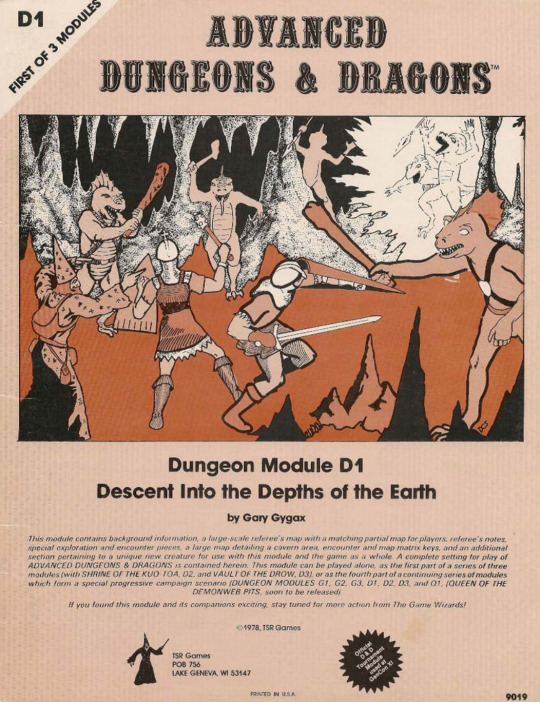
Ahh, 1e cover art. Looks like hot fucking garbage in the best way. Well, at least it's not a trace? You may be aware that early DND had a bit of an art theft problem (mostly stealing off of comic covers), but I don't actually have a list of all the known cases -- finding art credits at all is enough hassle as is without tracking down which paintings are also stolen. The usual suspect is "Greg Bell" and if you want to look this up the word you need to google is "Swipes", not traces. Just, be aware that's a thing going forward.
We start off on a weak footing: a light retcon. The ending of G3 didn't really imply that the drow had an escape route to the underdark in the Hall, at least not going off the map, but the text of D1 does. It didn't really even have a reason to pursue any drow into the, well it's not called the Underdark yet. In fact, it's going to be a hot minute til then, it'll receive that name in '86 from a not particularly liked supplement that got pumped out during the TSR Money Issues era. So for now, it's just The Depths. G1-3 were highly enclosed dungeons, D1 is a wilderness hexcrawl situation. Which is kinda strange, since like the G series, the D series was a tournament module. The answer to this conundrum, is that it isn't a conundrum, because only D2-D3 were used at GenCon XI, as well as an alternate Q1 that never was. Shame! The Lolth egg raid sounds cool.

A big hexcrawl, in fact! It's almost weird to me that D1 is the middle of a sequence at such a high level, rather than the beginning of a sequence at a low level, simply because there's so much stuff? Hexcrawls aren't my jam (admittedly I've only played in one ever, but I have Forever GM syndrome very hard so maybe one day that'll be fixed…) so it's hard to not see something this huge and go "wow this must be totally overwhelming to run". But we will press on dauntlessly!
We get some guidance on how to run this, including to really sell the "spooky cave" vibes. Gary is one again strangely invested in the importance of caving itself, but here it feels a bit more appropriate than it did in G2. Happily, shockingly, excellently: there IS a way to secure the Drow's favor from the word jump! Wiping out the Mind Flayer camp will have a, not 100% but extremely high chance of the drow FINALLY leaving you alone. Yay! And included in the module are some bonus cave battlemaps in case you need to random encounter in a cave. Also yay! Actually, in general in this introductory section Gary is generally sending out good game design vibes, going to great trouble to mention "if they're being careful, don't fuck them over" and "just straight up tell them you can't teleport very far down here" and "make sure you tidy up this framework into a real adventure". All very good signs!



The artwork is, broadly, much cooler than it has been up to this point. Which is good, because we're getting a whole lot of random tables here. They do a nice thing in this section, where they give 'purposes' to a lot of the random encounters, not full-on spark tables but at least knowing that the ghouls serve the drow is a very handy "why are they here?" to know.
The adventure lightly, reasonably, railroads you into your first encounter -- a checkpoint. It's a pretty rote fight, there are two factions but they can't really be posed against one another in any obvious way. The sub boss has a faerie fire grenade, and the big boss has a cloak that lets you turn into a lurker to fly away in a pinch. It's lightly teased that they worship Lolth here. But otherwise it's mostly just "welcome to the underdark motherfucker!"
There's a brief illithid encounter, which is likewise rote. Chop em' up and move on.
Finally, you have your dungeon-dungeon, which is a trog warren. It's mostly just Some Drow and Some Trogs, and it almost feels obligatory? It's got that "bunch of random caves" vibe that I do not like in dungeons. B1 and 2 will both end up doing this. But among the funny things is:
The first appearance of a death lance (drains d4 levels) on some bad motherufcker drow fighter lady
The medal you can negotiate from the drow can also just be looted
A lich is just, kind of taking a nap. the cheeky little fucker has put a magic mouth on basically everything everywhere, so you're flooded with magic aura if you think you're going to see shit coming. He's got some really neat shit, like a portable hole, but unfortunately his non-magic valuables are extremely cursed. Figures.
Sometimes I forget that ghouls and ghasts are sentient and intelligent, since I have had it so trained in my mind that ghouls are essentially smart zombies rather than people in any meaningful sense, but not so in ADND land! These ghouls are trying to ditch the drow they serve, which, understandable.
Thing I only learned now: ADND had many, many sphinxes. Andro (big tough and good), crio (smaller, dumber), gyno (smaller, a little meaner, classical sphinx behaviors including riddles), and hieraco (evil, vicious, and animalbrained). Ours here is the hieracosphinx, which is a pet of some drow lady.
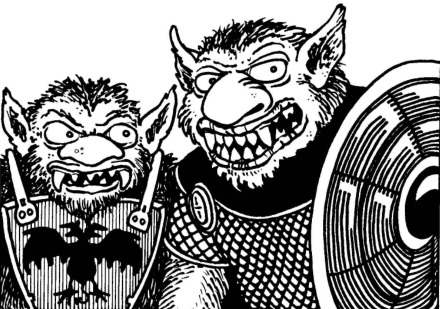
Hopefully we can agree that old timey bugbears were silly little guys. I don't buy that they're evil, they're too silly! And yawn the usual lady monster / child monster dilemma is here, how droll. Your party picked a side 30 sessions ago and now it's just procedural.
Apparently the dark elves and trogdolytes practice mutual aid with one another, though Gary specifies it's coercive so not like that put your flag down. I do think it'd be pretty funny to reveal that the trogs are Actually Really Good and have a lot to teach others about societal organization. There's not really much to say about it as-written, it's just more of that mothers/child dilemma tripe.
At the end, an actually cute little trick that I cannot fathom the party ever working out without the Drow Merchant just straight telling them: There is a room with a magical pool in it. The pool is surrounded by a ton of small gem, which if removed, magically reduce any nearby gems in size and value. But, if you toss gems into the pool, they increase in size and value. Neat! Infinite money machine!
The adventure ends with the unveiling of a new monster-people: the Jermlaine, which are basically just mean little guys who sneak around and cause trouble. Not really a threat, just extremely annoying. Your guys will wanna chop them up for being assholes, but really they're just like the most petty guy at your job. It's a weird addition, but not unwelcome. On the whole, D1 is some lovely and mildly ambitious connective tissue bridging the D series together, and I'm actually kind of fond of it now. Maybe my players will visit The Depths soon…
The adventure ends on an illustration of ya bois taking care of some trolls and shit. Thanks Dave!
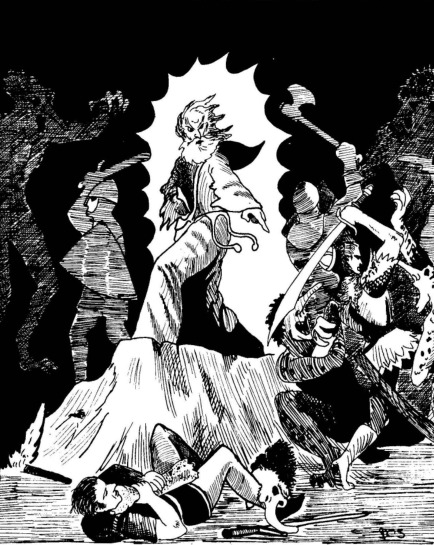
14 notes
·
View notes
Text
Pre-G1 Modules, part 1 - Temple of the Frog

So we're going to blow through this really fast cus there's a lot to cover -- I have 9 modules to go through before we hit G1.
G1 enjoys the reputation of "first DND module", but the reality is a little more complicated than that. G1 is more properly, "The first published standalone TSR adventure module". Which, as you can guess by the number of qualifiers, means it's not the first anything, really.
In the beginning, Tactical Studies Rules was Don Kaye, Gary Gygax, and Dave Arneson in a design capacity. They flopped around for a while, stealing copyrighted shit for money, releasing mediocre wargames, and eventually shrug and release DND anyway. It does very well. Don Kaye dies, they reorganize TSR into TSR Hobbies because Don's wife didn't like being involved, and we have enough preamble to get to Temple of the Frog.
TSR Hobbies had pole position to win the race to first adventure, and it worked, although for a variety of reasons (like Gary not really getting why someone would want to buy a premade adventure), they didn't publish discrete adventure scenarios. The first published, commercial adventure is technically in the original D&D ("Little Brown Booklet") supplement #2, Blackmoor: Temple of the Frog, and the dungeon is Arneson's.
Keeping in your head that Temple of the Frog is the literal first adventure is the very first adventure because this is basic as hell. There's a cult to the frogs, they're trying to make the most bestest amphibian monsters, and 1.0 twists.
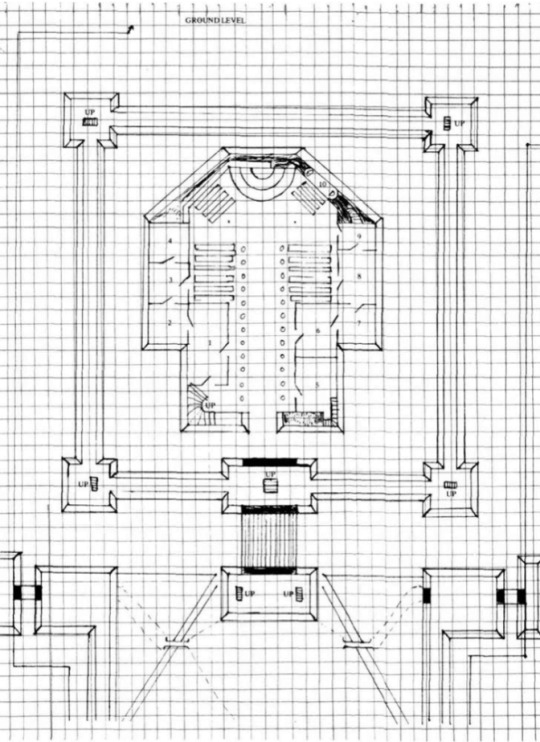
It's kinda charming though. This could be anyone's first map. My first maps looked kind of like this, in fact my first dungeon map was also a big church. A lot of early conventions are already here: a map is provided, on grid paper. Rooms are keyed, evocative descriptions are given (although this is actually pretty ho-hum, stating things as boring fact). The preamble is adequately interesting, but doesn't really establish any important context information about the actual conquering of this temple (the key system would be nice to have first, rather than buried halfway in, but be nice it's the first one). Conspicuously missing: any information about suggested starting level or party size. Now there is a old-school tendency that the levels of a dungeon should increase in difficulty about one level per….level.
In traditional Arneson form, there's some scifi bullshit going on. Here's some fast tidbits about this module:
The new head of the temple is an alien. His magic devices are all technological devices. There's spaceships. It's not my jam, but you simply have to accept that scifi/fantasy fusion was the trope of the time, it is completely ubiquitous in 70s fantasy books.
There is a weirdly complicated system of magic (technology) rings that control doors. There's a hierarchy to them that takes a whole page. It's clearly very important to Dave!
There's something about timeshifting that is, frankly incomprehensible to me. I do like hiding the big secret lair under a giant organ, though.
After you get through the first floor of so, so many people wandering around, we finally have monsters. A room of medusae (former captives), gargoyles operated with scifi bullshit, magic chains that turn off traps, giant rats and skeletons.
There's some very fun verbiage here, "each [medusa] taking 16 hit points". Like, taking 16 points worth of hits. It makes sense but there's something very fascinating of seeing this period where the metaphor of hitpoints is not just A Thing That Has Always Existed, but clearly something you have to explain to people and they are still thinking of it in less abstract ways.
Some further fun verbiage is that at this point, "Dungeons and Dragons" is a specific book that you can reference in the way you nowadays would say "Check the Dungeon Master's Guide". Check the Dungeons and Dragons! (Fun fact: the titular Dungeon with Dragons is, in fact, Blackmoor Castle's Dungeons.)

This sentence drove fear into my heart. You are bolder than me if you're gonna run an encounter that has 1,200 enemies in it. In what I can only describe as rank cruelty, cloudkill expressly doesn't work on them. And then the adventure just kind of ends. Dave, buddy, you can't tell me that the alien-priest reports back to the mothership and give me no means to go there. That's malpractice man! It would be my literal first port of call if I was rewriting this. I NEED TO SEE THE FROG FANDOM ALIENS' SPACESHIP.
Overall, the vibes are still very wargame. The building is a castle that feels like it's meant to be sieged more than raided. But it's the first! Anyone who runs this in 2024, and in a modern game engine, deserves a kiss on the forehead for their hard work.
13 notes
·
View notes
Text
Pre-G1 Modules, part 2 - Palace of the Vampire Queen and DK1-3
Asterisk 1: The first standalone module, Palace of the Vampire Queen
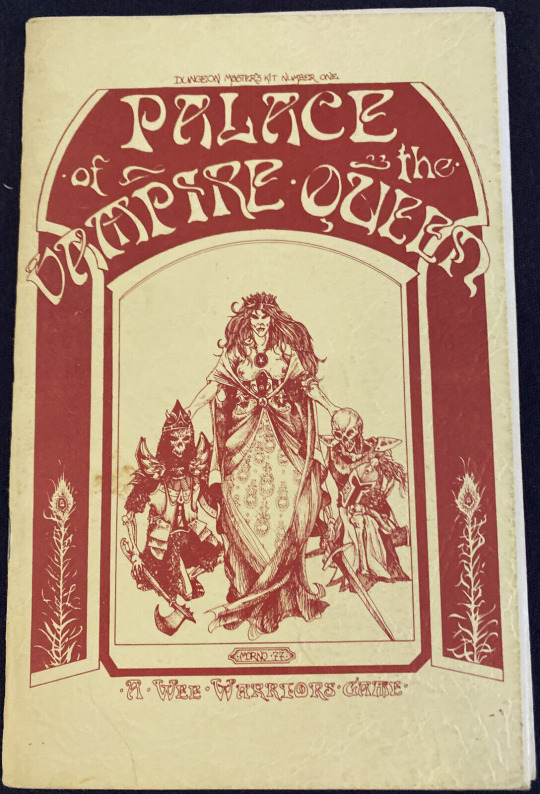
(Another proud DND tradition, evil woman with her tits hanging out, representing here. This adventure is by Pete & Judy Kerestan, the operators of Wee Warriors.)
I'm trying really hard to not get TOO bogged down in exterior details to the adventures themselves, but a small preamble about Wee Warriors. Wee Warriors was a little company that was born to publish DND supplements. They were one of many, there were many zines and magazines and fan supplements going around, for example Judge's Guild forms at roughly the same time. They worked with TSR after a while to publish these things, so they were unofficial-but-official in a weird way. Early DND culture functions less like a business and more like a hobby community. Most of the early DND people knew each other in some capacity, it's only when DND got really far away from Lake Geneva that distinct cultures started forming island effect-style.
Good enough, let's keep going.
Our preamble gives us the basic of the adventure, dwarf island harangued by vampire queen, the undead keep abducting people to eat their blood. Conspicuously absent is any kind of information about a suggested level or party size.
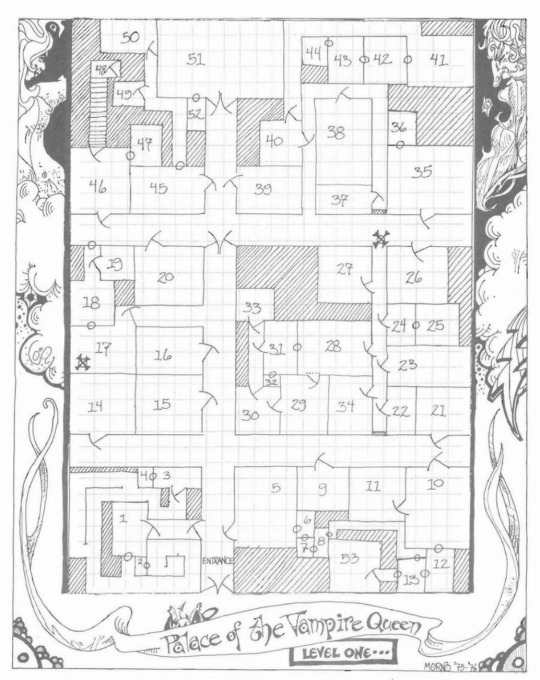
It's cute, right? The styling is so welcome and loving in a way that TSR products will not have for a long, long time.
It's very rote, lots of very basic traps and stocked rooms. Not much to see he--

T-telepathic kittens that improve your morale? This is one of those moments where you just instantly know. The hobby isn't as different as you might thing. This is the exact sort of adorable shit you'd see on one of those big streamer shows. We all love our cats. They are our strength.
There genuinely isn't much to say about the rest of the module, other than that there is a shocking amount of child murder. There is an evil castle with a vampiress in it and you gotta go whack people til you can claim the reward money. About the most interesting twist you'll find in here is that there's a fakeout queen, and that the genuine queen will immediately take the (unnamed) dwarf princess hostage to secure her escape. I do appreciate that, if you're going to make every room just be a combat encounter with loot in it, the decision to make the key a table with room/creatures/max damage/description is sound. I'm kind of surprised this table-style key never caught on, given the 'doom monster closets' design that typifies a lot of early DND.
I wish that there was a great revelation waiting here for you, that the first non-TSR adventure was a forgotten classic? But it's really not. It's some monster-stocked rooms with the rare trap, and a vague preamble. Temple of the Frog showed a lot more creativity. I am kind of strangely fond of these lovingly inked maps though, it makes me long for hand-inked maps again. The Dungeon Master's Kit product line continues for two more entries (The Dwarven Glory and The Misty Isles) to form a soft trilogy.
Bonus Round: Skimming the rest of the Wee Warriors Dungeon Master's Kits
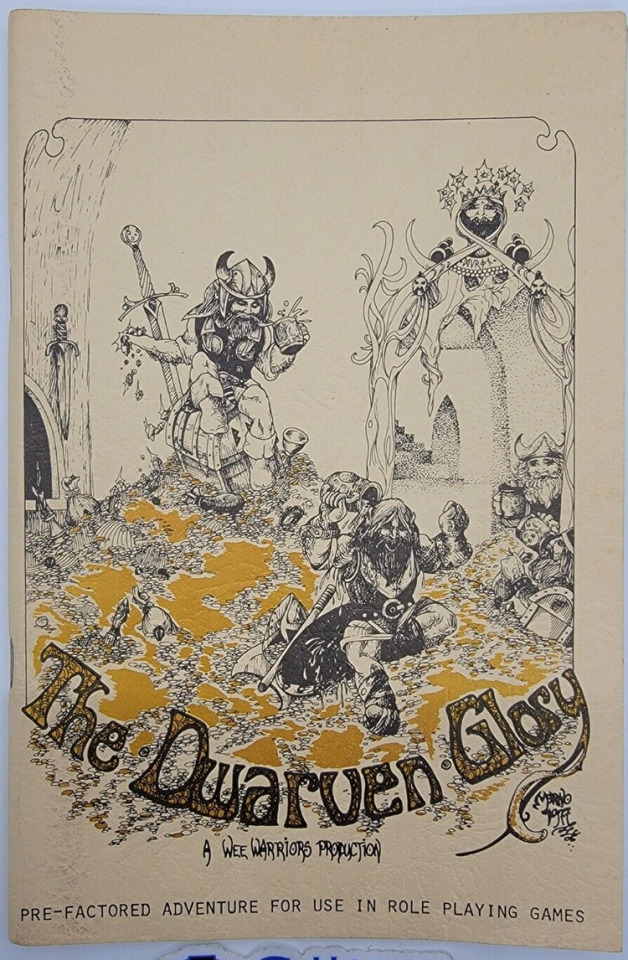
So the thing about the DK product line is that it's not very interesting. But since I had to get a copy, I'm making it your problem by talking about them more.
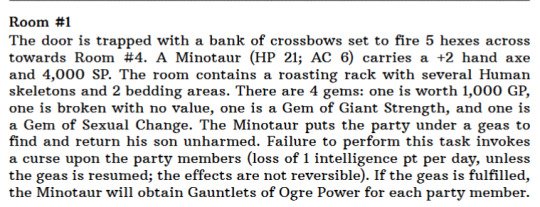
Everything about this room fascinates me. There is so much going on here that isn't explained. And then you keep going to room F7:

Again, nothing is fucking explained. The monsters are in conflict because why not? There's actually a great idea in here, (although again, why is child murder so prevalent?)

There are wisps of interesting narrative here, but all that's actually presented is like…the end-state? "Evil high priest who is abusing a tragedy to push his agenda" is a solid plot point. The idea that returning the treasure can cause conflict is great. But also, holy shit 500k gp diamond. That's enough exp to max your character in one fell swoop???
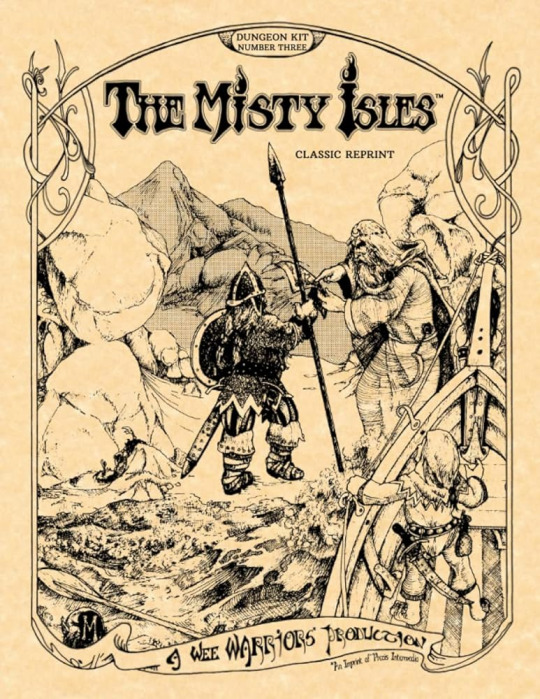
Moving onto Misty Isles, this is more of a…. setting than a module per-se. There's some implied plots I suppose. Here's some of the weirdest things:
The leader of the dwarves on one island is implied to be gay, which is a strange decision given how we don't have any other practical information about him, and has melted all his gold into one pile
A profit-prophet who gives oracles for bribes
Many, many dwarf seems to have access to actual modern day machine guns?
A band of monks are looking for a girl stolen by zombies. Why….did they steal her? Why is there hope of rescuing her? They're zombies, they're going to eat her!
I cannot do this justice myself:

That's….that's a lot. You want to randomly roll for nearly 600 magical objects? Sometimes designers Simply Say Words. The "My PC is the most bestest guy ever and could never be defeated" stories you hear people whinging about take a very different context when you realize there's just, GMs running around handing people literally 600 random magical items. Eventually you're going to roll and get the best items in the game. Note also, literally zero way of detecting any of the traps.
This random paragraph implies the existence of gamemaster-less play, a thing I guess could hypothetically exist with the degree of randomization, but. What?

Absolute queen shit. You go succubus lady! And the fairytale logic is cute cus, if the party got mad when they found out about this, they could always give her weight from some magic bullshit, like turning her into lead. Oops!

And it just goes on and on. There's a Cthulhu reference, there's a party of fighters who casually want to rape women (why were 70s gamers like this), the obligatory slavery character, et c. It's not the first setting released for DND, there are multiple people in front of this, I believe Empire of the Petal Throne won overall [fuck MAR Barker, nazi scum], and City State of the Invincible Overlord certainly predates it by a year. In 2024, it's a pretty tedious read. It reads like a list of ideas, because it is. There's some maps, but the maps are very sparse.
12 notes
·
View notes
Text
Purpose & Index
This blog is a project for me, and maybe you, to walk through DND's modules in release order. So this blog has basically 3 goals:
Show off some weird interesting ideas from older modules
Shine light on obscure modules
Look at how modules grew as an art-form
Isn't that's fun and interesting?
Index
I will try to keep this up to date, bug me if it goes untouched for too long..
Pre-G1, part 1: Temple of the Frog, Dave Arneson (1975)
Pre-G1, part 2: Palace of the Vampire Queen, The Dwarven Glory, and The Misty Isles, Wee Warriors (1976-1977)
Pre-G1, part 3: Lost Caverns of Tosjconth, WinterCon Ver. (1976)
Pre-G1, part 4a: City-State of the Invincible Overlord, Tegel Manor, Modron, Judge's Guild (1976-1978)
Pre-G1, part 4b: The Thieves of Fortress Badabaskor, GenCon IX Dungeons, Citadel of Fire, Judge's Guild (1978)
Pre-G1, part 5: The Tower of Zenopus, Eric Holmes, (1977)
G1, The Steading of the Hill Giant Chief, Gary Gygax (Jul 1978)
G2, The Glacial Rift of the Frost Giant Jarl, Gary Gygax (Jul 1978)
G3, The Hall of the Fire Giant King, Gary Gygax (Jul 1978)
D1, The Descent into the Depths of the Earth, Gary Gygax (Aug 1978)
D2, Shrine of the Kuo-Toa, Gary Gygax (Aug 1978)
D3, Vault of the Drow, Gary Gygax (Aug 1978)
S1, Tomb of Horrors, Gary Gygax (Oct 1978) 7.5. 1978 Reflections, and the Halls of Mystery (Dec 1978)
B1, In Search of Adventure, Mike Carr (January 1979)
T1, The Village of Hommlet, Gary Gygax (August 1979)
10 notes
·
View notes
Text
No. 7.5 - 1978 Reflections, and the Halls of Mystery
Welcome back to the end-of-the-year recaps! This is technically the first TSR iteration of it!
1. Coolest ideas
It's a lot of stuff from D2. The big ticket item is "neutral-ground hostile shrine" -- any time you can muck about with otherwise hostile people without drawing swords immediately is a big win. I know that the reaction table is supposed to mitigate that some but, cmon. Sometimes you just can't think of a good reason that the 9th goblin pack tonight is not immediately hostile. This is a way more natural way to handle it. And it lets you talk and such and experience their culture from their perspective!
2. Coolest Module You Haven't Heard Of
This is honestly a hard one because all of these modules are intensely well known. Gun to my head, I would probably vote for G1. The D-series is cool but frankly there have been more better and more interesting iterations of subterranean hexcrawls -- Veins of the Earth being the currently famous one. But the thing about G1 is, G1 is a surprisingly natural and fun location. Unlike the others in the GDQ series, G1 is genuinely an adventure you could slot anywhere with no context. It is simply a fun raid on a fortress, which I never get tired of. The twists of "they're piss drunk" and "there's a slave revolt in the basement" are really good (albeit in 2024 a little stale) twists on the classic raid-on-fortress formula.
3. The Growth of Module Design
Honestly 1978 represents a rather stagnant year for module design. The most innovative design feature I see is how D1-D3 feeds into one another in a much more naturalistic way than its predecessors, and all through that deeply useful combination of hexmap and random tables with a handful of pre-programmed setpieces. I am eager to see hexmap technology get much better going forward.
…
Surprisingly, 1978 wasn't too much to talk about? I don't generally think of Gary as an "innovator" in module design space. His main contribution is taking things that already exist and making them feel more natural. Which is not to say that I now buy into Gygaxian Naturalism as this great feat, more than a lot of his competition at the time was seemingly intentionally anti-Naturalism. Their work feels like the reaction to me, Gary is just staying the course of "this should make an amount of sense". Although, his random dungeon monsters mishmash still feels as nonsensical as all hell.
The Halls of Mystery (From Dragon 21, December 1978)
And as threatened, we're going to have a very brief section on The Halls of Mystery, which holds the dubious honor of 1st Dragon Magazine dungeon. I would throw the full header at you, but everything is by Don Turnbull. You may recognize his name, at publication time he works for Games Workshop and he will be heading up TSR, Inc.'s UK branch starting in 1980, leading to the much-beloved Fiend Folio.
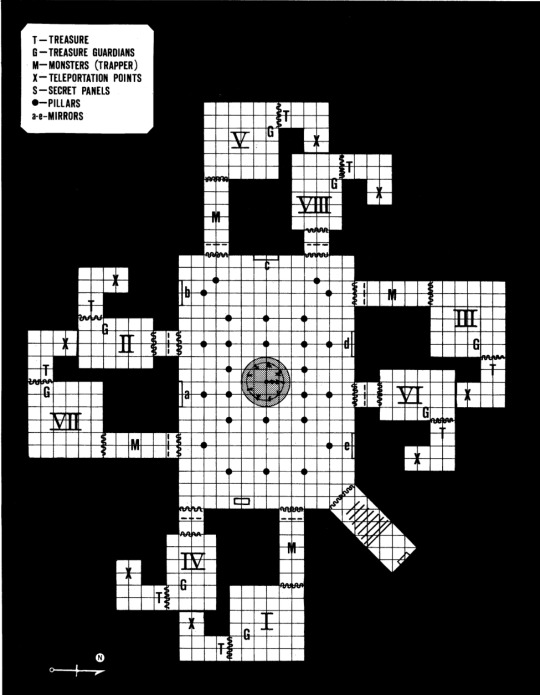
So. Not much to say about this, actually, It's a very large room with some branches. The main schtick of the Halls is that the main chamber contains several mirrors, some of which are magical. There's a big riddle on the desk on the south side, the riddle solution is actually quite obvious (say Excalibur three times -- and hey, Don told us the answer and rationale of the puzzle! Thanks Don!). When you move the central cylinder, it teleports you to the corresponding position in the dungeon. The rest is a lightweight stocking of the dungeon with monsters, treasure, et c. If you're keeping score, this is a Zelda puzzle. It's very cute and lightweight and honestly it's so neutrally written (no statistics are given and it would be trivially easy to restock it at any level) that you could genuinely use it in 2024 with very little effort. It's adorable! It is also wonderfully lean, clocking in at two total pages and frankly it's super refreshing to have such a light read of a module here.
Happily, next time we will be covering B1 - In Search of the Unknown, which is the second Basic D&D adventure we will be reviewing in this series (The adventure printed in the Basic rulebook, Tower of Zenopus, was first. This is our first lettered Basic adventure.) And, funnily, the first TSR module in this lineup I've never read before. See you then!
8 notes
·
View notes
Text
No. 7 - S1, Tomb of Horrors (October 1978)
Author(s): Gary Gygax Artist(s): David C. Sutherland III (Cover), David Trampier Level range: 10-14 Theme: Meatgrinder Dungeoncrawl Major re-releases: So, so many. S1-4 Realms of Horror, Return to the Tomb of Horrors, Tomb of Horrors (2005), Tomb of Horrors (2010), S1-4 Dungeons of Dread, Dungeon #213, Tales from the Yawning Portal, Tomb of Annihilation (sort-of)
I said earlier that S1 is probably the only adventure more ported than G1, and I was right. You have so many options for S1. The original monochrome, the green cover, the compilation version, the silver anniversary version re-erlease-and-sequel, a 3.5e port, a 4e port, a DND Next port w/ 4e porting instructions, and then finally the 5e port in Tales from the Yawning Portal. The only people being left out here are the 2e people, and making 1e adventures go into 2e is as natural as breathing.
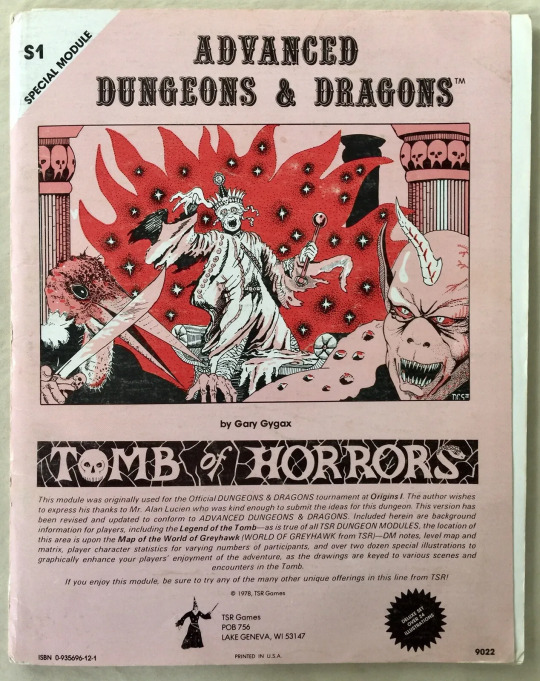
As the cover points out, this was originally run at Origins I, and there is so much community lore surrounding this module that I will spare you the rigamarole. If you know where I stand on the "meatgrinder vs fair challenge" argument, go read the Theme header again.
These illustrations are iconic. In basically every re-release they are kept as is, one of the few things that makes the 5e release stand out is not including the original 31 illustrations. And while the new art is OK, I, it can't hold a candle to the sheer charisma of the originals. And -- why no green devil head? That's the single most memorable thing from the scenario? We get one, actually, but it's on the map and I think it's an image from the archives because it looks an awful lot like an old cover of Dragon. If you do run this in 5e, you really owe it to your players to hunt down and use the original illustrations.
I am now morally obliged to tell you that, when I went through Tomb of Horrors (5e version, that's what I can find GMs for), I died to the Juggernaut. Which is actually extremely funny, because earlier when I was in Tomb of Annihilation I died the exact same way! So I guess Juggernauts are my personal arch nemesis. I personally didn't like my time there, but there is value in a module that everyone has played. I wouldn't've picked S1 for the task but I'm glad we have one at least. In general, this will be a a sparse entry in the series. The Tomb of Horrors is Tomb of Horrors. It is both extremely notable and also weirdly bland -- there's just not much to say about a lot of these trollish traps. They're highly specific and only really work in the moment, for very specific tables, at a very specific cultural moment. It's actually kind of boring to read in 2024? How much can one really say about a 20-colored mural with a variety of "it does nothing" effects?
Alright, enough stalling. The module starts with now-traditional Gary intro of "hey, your players are going to try and get extra information in [obvious way], defeat that." Today's edition is that Legend Lore is rendered useless by a combination of obscurity and….too much information? Ok… And then the also very Gary "If your players are dumb stupid idiots they will hate this module", which he also did in G1-3.

Eventually, your party finds this stupid looking thing, which is (I know this is repetitive) iconicly so-bad-its-good. And everything about this intro is trolling. So There are three routes into the tomb, two of which are trapped and fake. 2024 DND players would never think to try any of these things, but I do get the sense that in 1978 it would've occurred to most veteran players to try things like "poking the wall with sticks" and "extensive excavations". Anyone who tries to be clever and bypass shit by phasing into a parallel plane gets got by Demons, and I like the theory that Seth Skorkowsky aired a while ago that the Demons are the ones maintaining the Tomb so you should steal that.
You know what? Let's just go into keyed mode.
I do not respect this "only these express options work" mindset. It's very anti-ttrpg to have pre-programmed solutions Naturally, the second door cannot be removed by strength, only by one of 5 spells and thinking to wedge the door with iron in a specific day works. IDK bro I know the idea is Acererak is an asshole and has bewitched this complex to high hell but cmon, even the fake doors are borderline invulnerable?
There's a riddle-poem that hints at the solutions to the dungeon's puzzles. I actually really like this poem, and for all this module's sins I disagree with commenters who think the poem is too vague. At least when I was playing, it was just right.
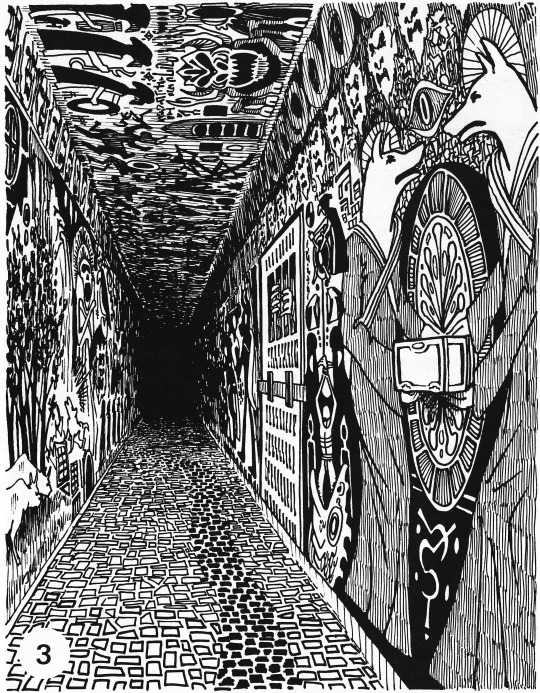
That is the most off brand Ancient Egyptian tomb hallway I ever did see, and I do kind of love it. As for how confusing the wall-door-chest trap is, it's trollish but it makes sense to me. The chest is a red herring to distract you from the actual secret door, which is a literal door, and honestly that's a hint I consider fairly on the nose.
The misty arch sucks. The short version is that if you press the glowing stones in the right order, you progress, otherwise you get teleported to one of three random rooms. The solution is inscrutable to me (why that order? you could brute force it but that'd be suicide) and I really wish that the book spelled out what the puzzle logic was -- a lot of newer adventures will explain the operating logic in parentheticals next to the solution. If the answer is "you're supposed to brute force it", I have no respect for that mindset.
The devilhead is obviously iconic as hell and we love it. As many commenters have noted, the often-cited "our whole party climbed in and died" story is incompatible with a RAW or RAI interpretation -- your GM was just an asshole, your character died as soon as their head got annihilated and the party would see their body go limp suddenly. There is no way all 5 of you piled in without removing a body and discovering they're Very Dead.
The lever room also sucks. You could only guess the solution, and the act of testing will get you killed. And don't give me "well your hirelings" your hirelings are not going to test any traps after they see the 2rd guy get turned into meatpaste, and while ADND lacks the hard cap on people hireable that Basic had, you're still going to run out of guys who are willing to commit suicide in here in short order.
"Yet there are also depicted various religious symbols of goad alignment, and a faint aura of good can be magically detected. What a puzzle! Could the demi-lich actually have been of good alignment" This will fool no-one Gary. It's the Tomb of Horrors, not the Tomb of Hope. He clearly bewitched the chapel to appear as good, which literally anyone would think of. Heartbreaking: worst lich you know has access to revolutionary SRS magic.
It's at about this point where I realized how little there really is to comment on in this dungeon. It really is just a sequence of obtuse murder traps that are faintly hinted at. The things that are iconic about it (the devilhead, the acerack fakeout) are actually exceptions to the rule -- both of those are super clear traps that are designed to tease particularly foolish players. The majority of the dungeon is, tap random objects and get gassed by poison or dropped into spikes. In a lot of ways ToH feels like the bad timeline version of White Plume Mountain, which is trollish in a more memorable way? What I mean here is, when people complain that ToH is unfair they're burying the lede. A hard dungeon can be fun. An unfair dungeon can be fun! The issue is that Tomb of Horrors is boring. Every room being a puzzle tied to a deathtrap with almost no combat or negotiation is tedious.
Basically every tomb of horrors room has this setup:
You walk into a room with an illustration that looks cool, and there is some vague image, object, or feature in the room that is conspicuous
There is either no obvious exit (strongly implying a secret), or an extremely obvious exit that is currently impassable
You have to try fiddling with any object in the room that can be fiddled with, or grope around for an illusion
There is a roughly 25% chance there is a vague hint from 3 gameplay hours ago that will help you if you interpret it correctly, and a 75% chance that this is intended as attrition
You fuck around for a while, and maybe you work out the puzzle and maybe you don't. Almost certainly, someone takes 50% damage or has some vital asset removed or changed about them.
You eventually pass into the next room
Really the variety of traps in this dungeon is surprisingly narrow -- something like half of these traps are "activate these objects in a specific order or orientation". The other half are some variety of mist or gas or cloud or other fluid that kills you if you do not avoid or interact with it in the specific way. Occasionally when you're lucky, you simply turn a lever and get skewered -- what a treat!
The final encounter with Acereak, you will be unsurprised to learn, also sucks. If you touch his jeweled skull, he instantly steals your soul and ruins your body (no save, no appeal). If you guess one of the, again, explicit list of options to destroy the skull (which you have already established will instantly kill one ally per touch) which is of course very specific (essentially, holy attacks, the most powerful magical swords, and inexplicably gem-slinging), you can kill him in 50 hp. Weirdly, the soul gems that you get trapped into do offer some escape from death, but it's a terrible one -- IF you pass your save, IF they crush the gem, IF there is an eligible body for their soul to go into (yours was ruined), then you may come back to life in a very different form. Completing the Tomb gives you, of course, 100k exp. And in ADND that'ssss…. actually not very much. At level 10, 100k exp is not even a full level for most classes to get a level (thieves are the exception) and your actual treasure haul I think is going to be fairly meager -- I think the average character will get maybe one level of experience after distributing the loot. For going through one of the most dangerous dungeons ever.

I remain a bit of a ToH hater.
In blog news, we are looking at post 7.5 coming up, in which I will do another retrospective on the year's developments, and as a special treat we will be briefly discussing the first Dragon Magazine dungeon!
11 notes
·
View notes
Text
Pre-G1 Modules, part 3 - Lost Caverns of Tsojconth
That's Tsojonth, with the O. Many early adventures debuted not in published form, but in home games and tournament modules, and Tsojconth is the most famous example. This will actually be a super brief post because we'll be talking about Tsojcanth later in more detail, when we're in the full press of the TSR module era. Tsojconth debuts as a module for the tournament at WinterCon V in 1976, and it's a Gary Gygax number. That's right, G1 isn't even the first Gary module to make it to public consumption! Anyway, WinterCon was set up by the Metroi Detroit Gamers. You *could* actually buy this module, although it wasn't "official" TSR fare.

Again, I kind of miss the hand-inked era of TTRPG art. A lot of people are fans of that pre-big money TSR look that is very evocative despite being not very proficient, and I feel like this hand-penned look is the prototypical example of this. This is literally just a road with some guys walking into a cave in the mountains past a graveyard, and yet the vibes are *immaculate*. Side note, I am personally very fond of Tasha (Iggwilv), so I'm always happy to see her earliest depiction is super early here, even if she is a contextless name.
In a nice little touch, all the parallel games of Tsojconth at WinterCon V were all canon to one another. That is, Tsojconth is a "nexus of probability", meaning that you can conceivably meet other players playing the same pre-generated characters in your session. It's cute!
If you are not somehow aware of the concept of a tournament module (especially if you're a 5e player), here's the quick rundown. The high lethality and unforgiving nature of early DND meant that "winning" DND was still considered a thing you could do. Remember, DND was born from the wargaming scene. Consequently, they would compete in tournaments at conventions to see which group of people could clear a dungeon, and among those who could clear it with the most treasure, least mistakes, and least casualties. This is part of where the "impartial judge" mindset comes from that you often see in graybeard gamers, its got its genetics in the competitiveness of wargaming. That's not to say your uncle Joe *only* believes this because he played tin soldiers in 1970, but that's part of it. Damage did average damage, wandering monsters were disabled (their game design utility doesn't really matter if the players are already trying to go as fast as possible and there's no campaign after this), healing was standardized, et c. Points would be tabulated at the end.
Interestingly for Tsojconth specifically (I don't know how generally true this is), at the halfway point survivors of the lower caves would be integrated into new groups for the next level, Survivor-style. Again, it's very cute.

Eck. I don't know if it's the old xerox job or what but this looks like shit! I'm not much of a paper map person, I usually use mapping software, but my few on-paper dungeons look....a little less slapdash than this. Maybe it was in a rush?
I get that they're trying to conserve paper because this is for a tornament but the font is killer on my eyes. Anyway! There is not much to report that will not be covered eventually in the S4 post, so I will instead leave you with a quick collage of illustrations, and finally a *vintage* character sheet. Cya later!

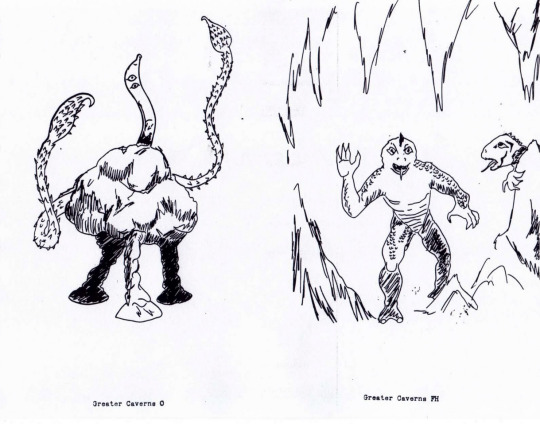
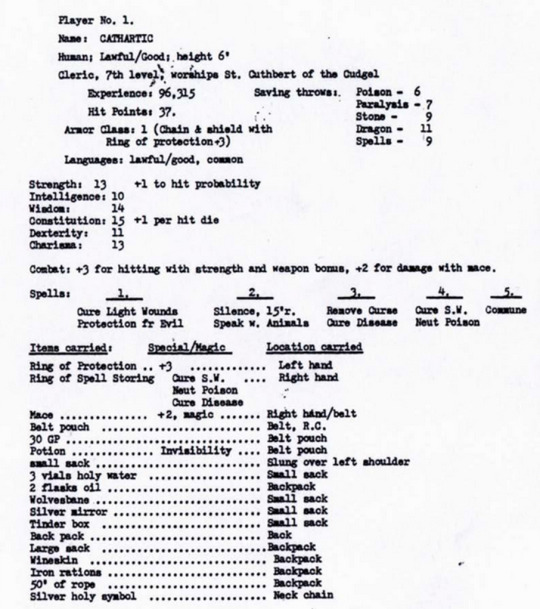
9 notes
·
View notes
Text
A Small Appendix: What's a Basic DND?
A lot of people get confused about what a "Basic DND" is. Here is a quick explanation. It's a series of deeply compatible games descended directly from the original DND, without being via ADND:
1977: Holmes Basic, "Blue box". Still essentially ODND.
1981: Moldvay Basic, "B/X", "Moldvay-Cook". Note that Moldvay edited Basic, Cook edited Expert. Basic/Expert, B/X. Still essentially ODND, with babysteps away.
1983: Mentzer Basic, "BECMI". BECMI is an abbreviation for the chain of box sets that make up Mentzer's series: Basic, Expert, Companions, Master, Immortals. Mentzer basic is the biggest single step away from ODND, changing a few rules.
1991: Denning Basic, "Black box". Officially, The New Easy-to-Master Dungeons & Dragons Game. Very rarely discussed beyond the tutorial cards that came with it.
1991: DND Rules Cyclopedia: A repackaging of BECMI, without the I, into one volume.
1994: Stewart Basic. The Classic Dungeons & Dragons Game officially. Very rarely discussed.
For all intents and purposes, in 2024 the ones you'll see discussed are Holmes, Moldvay-Cook, and Mentzer. And no, that thing that looked like Mentzer basic they sold for 4e and 5e is not actually basic, those were just regular introductory sets for 4e and 5e respectively.
Oh, and if someone says something is "basic-compatible" or "inspired by b/x" they almost always mean Moldvay basic. The giveaway of DND Basic lineage, to me, is race-as-class mechanics (eg. your class is Elf). No one else really did that because it's a really bizarre way to essentialize race (I mean, don't essentialize race at all). Most modern hacks have some kind of optional rule to remove it because it has been very unpopular, as far as I can tell.
8 notes
·
View notes